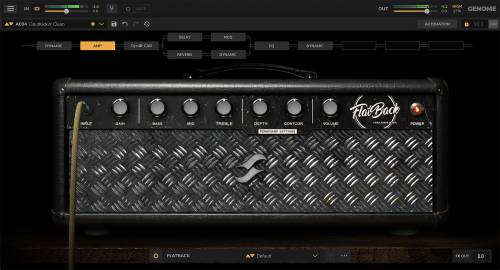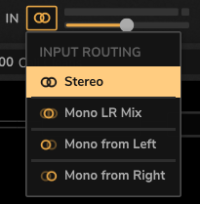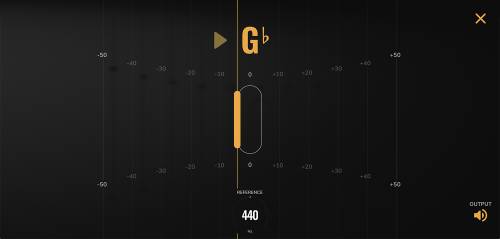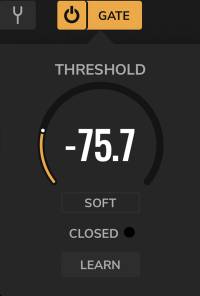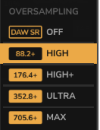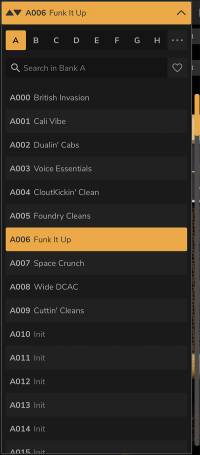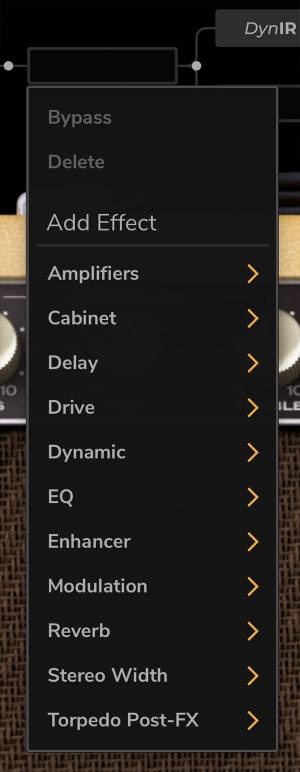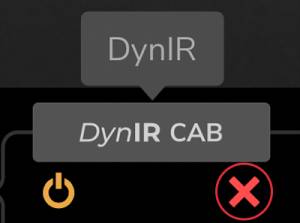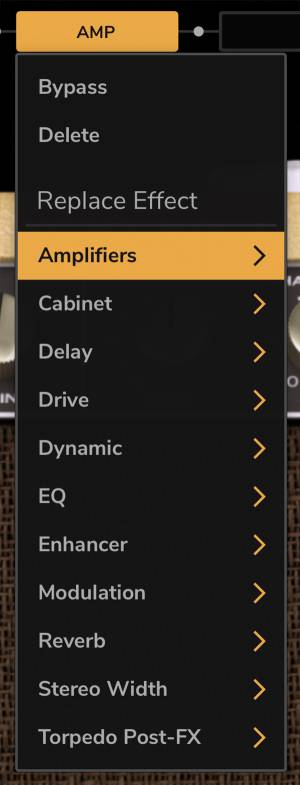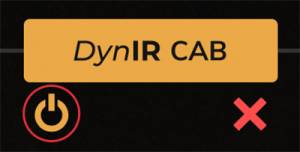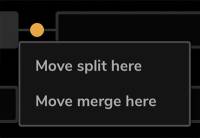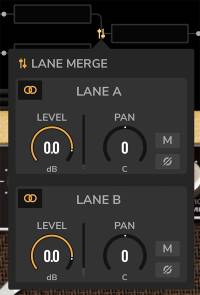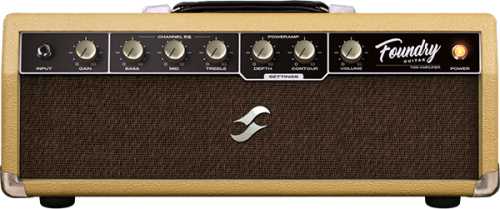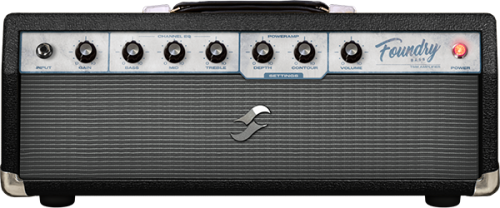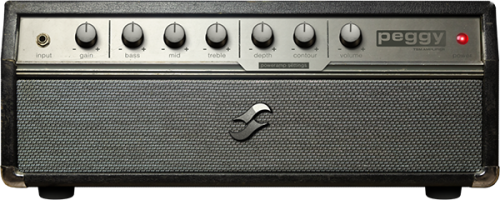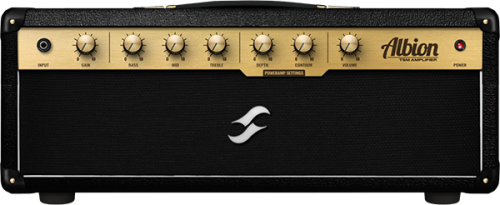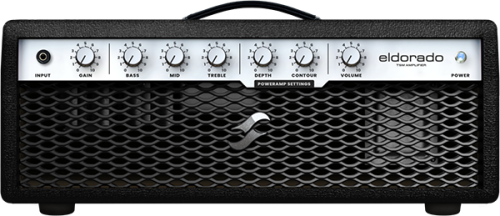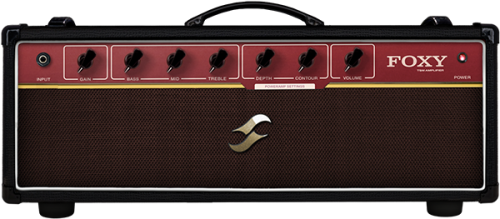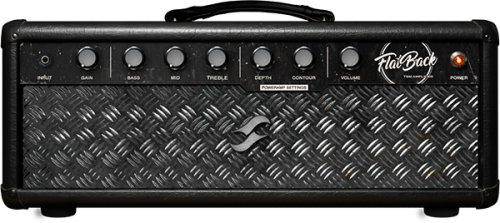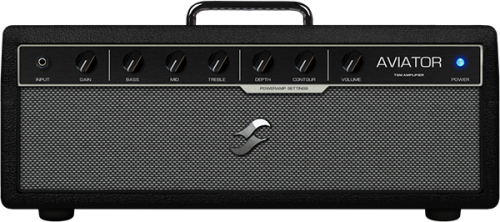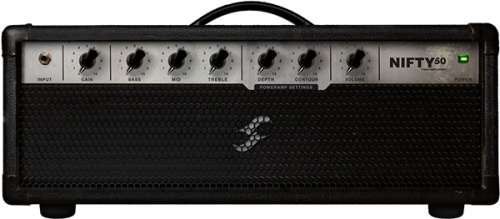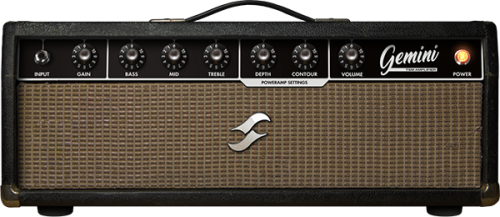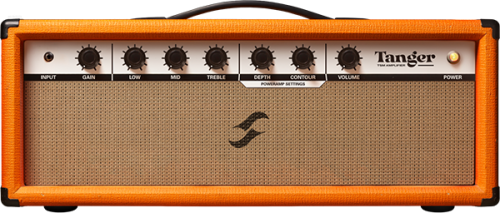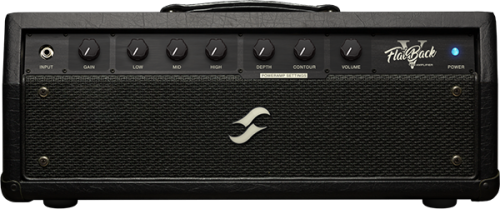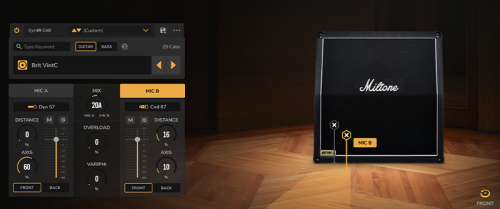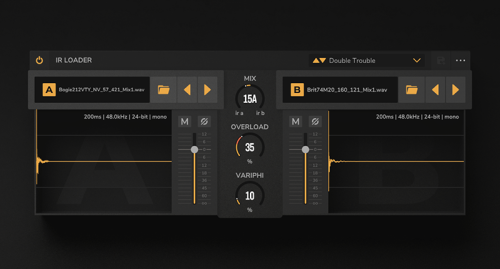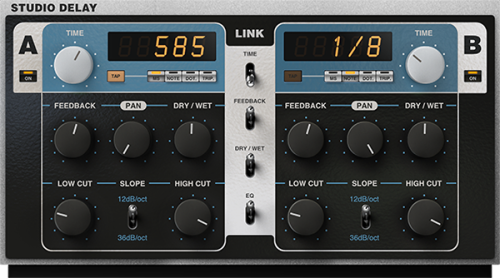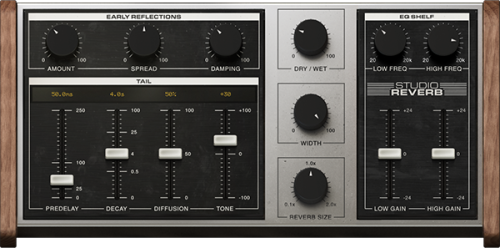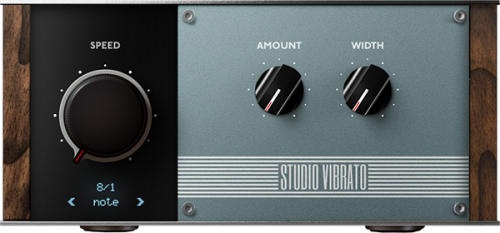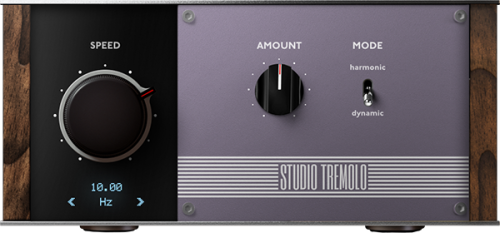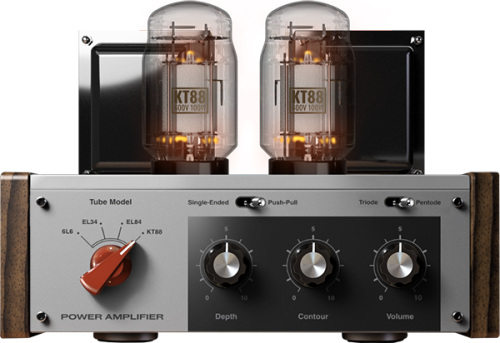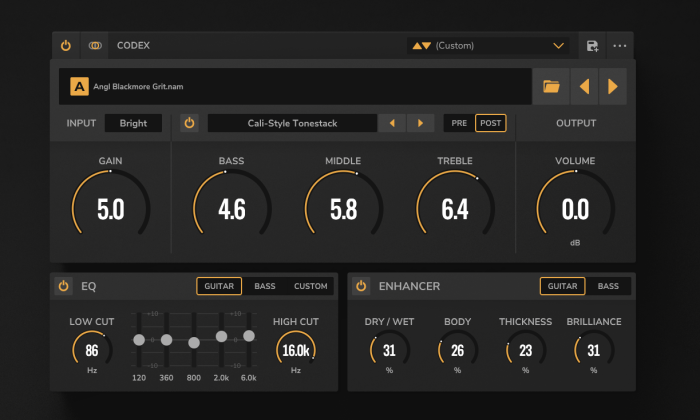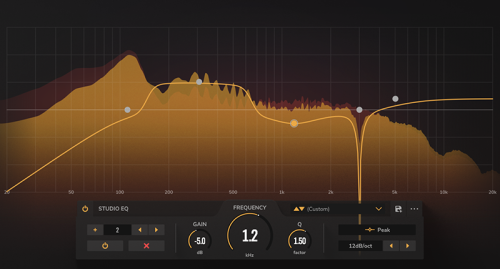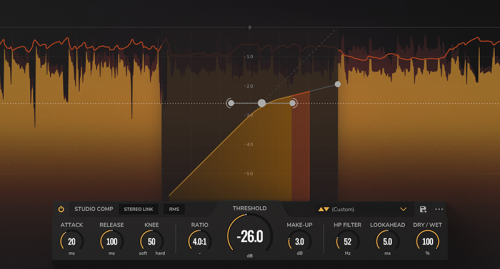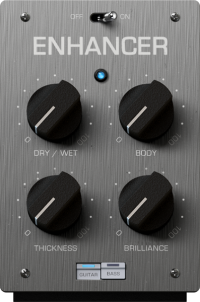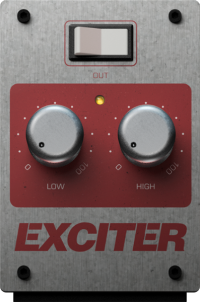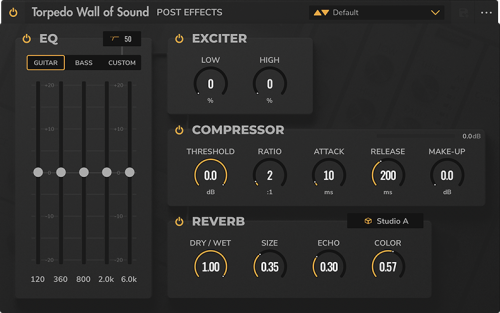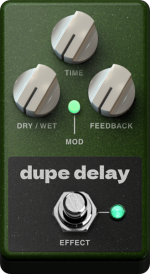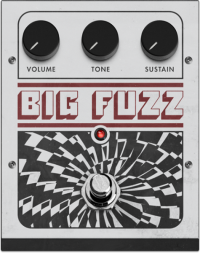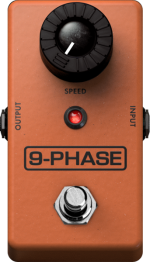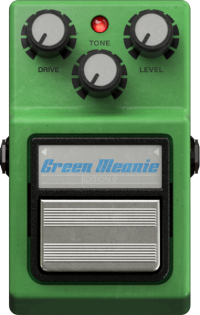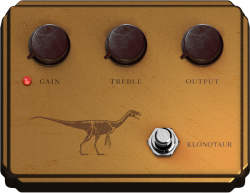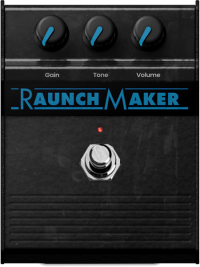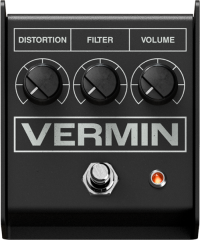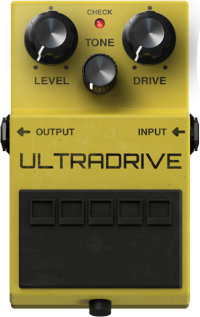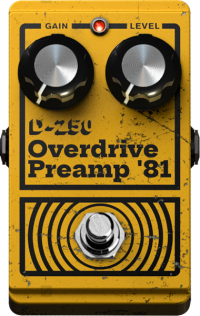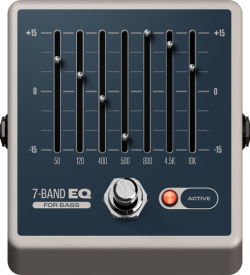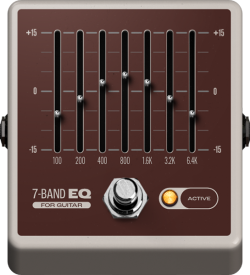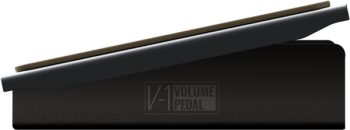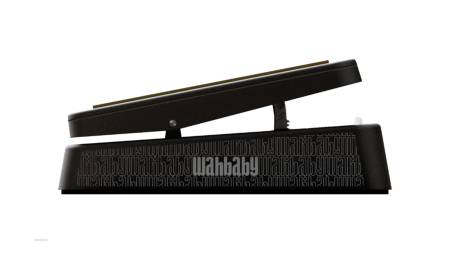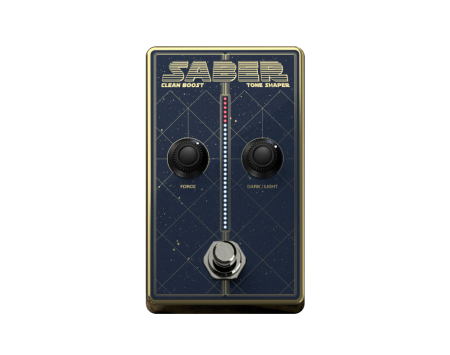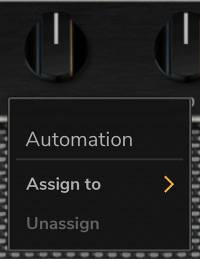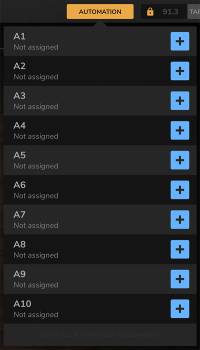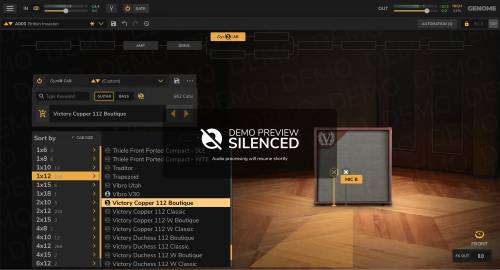Table of Contents
GENOME User's Manual
Adaptive Channel Strip Powered by Two notes’ Proprietary CODEX, TSM™ Amplifier, DynIR™ Cabinet & PEDAL Engines
The complete electronic version of this manual, and the related GENOME software application, are subject to updates without notice. To download the most up-to-date manual for GENOME - alongside user guides for all Two notes Audio Engineering products - head over to the Two notes Audio Engineering website.
This manual describes the use, features and functionality of Two notes’ GENOME plugin application, detailing comprehensive instructions for its intended operation. It is highly recommended that you read this document before using the software. The contents of this manual have been thoroughly verified and is believed, unless stated otherwise, to accurately describe the product at the time of download availability from the Two notes Audio Engineering website.
Two notes Audio Engineering is a registered trademark of: OROSYS SAS 76 rue de la Mine 34980 Saint-Gély-du-Fesc France Tel: +33 (0)484 250 910 Fax: +33 (0)467 595 703 Contact and support: http://helpdesk.two-notes.com Website: http://www.two-notes.com
This document is the exclusive property of OROSYS SAS. In the interest of product development, OROSYS SAS reserves the right to change technical specifications, modify and/or cease production without prior notice. OROSYS SAS cannot be held responsible for any damage, accidental or otherwise, that results from inappropriate use of GENOME. Please refer to the safety instructions included in this manual.
The reproduction of any part of this document is strictly forbidden without the written authorization of OROSYS SAS.
All product names and trademarks are the property of their respective owners. Product names and trademarks found in this document were used during the development of GENOME but are in no way associated or affiliated with OROSYS SAS.
Foreword
1. Reader Warning
2. Correct Use of a Loadbox
GENOME may be used either with real-time or prerecorded audio sourced from DI instrument feeds, guitar/bass preamplifiers, hardware amp simulators (Including ReVolt Guitar, ReVolt Bass, OPUS), and/or a tube/solid state amplifier in conjunction with a suitable loadbox (Including Two notes’ Torpedo Captor, Torpedo Captor X, Torpedo Reload). While using a DI instrument feed or the line output of a preamplifier / amp simulator is comparatively safe and simple to administer, using the speaker output of a tube amplifier in conjunction with a loadbox requires caution.
2.1 What is a Loadbox
In routine use of a tube amplifier, it is highly recommended that the power output of the amplifier is always connected to a speaker cabinet or suitable load prior to powering on. The speaker cabinet (rated at either 4-, 8- or 16-Ohms) must always be connected to the corresponding speaker output of the amplifier. Neglecting to do so can lead to partial or complete destruction of the output stage of the tube amplifier.
The majority of tube amplifier designers protect their products with fuses or alternative suitable protection systems; however, some amplifiers are still insufficiently protected. It is therefore impossible to predict the behavior of all amplifiers on the market in the instance load (be it a speaker cabinet or a loadbox).
The electronic term that describes the speaker cabinet with respect to the amplifier is the “load”: we say the cabinet “loads” the amplifier. The term “loadbox” is used to describe any product that provides a load to the amplifier. The main parameter of the loadbox is its impedance, expressed in Ohms. Impedance matching between a loadbox and amplifier is paramount and as such should be actioned wherever possible (i.e. an 8-Ohm loadbox must be plugged to the 8-Ohm speaker output of the related amplifier).
The power sent by the amplifier to the corresponding load is turned into heat; as such, it is vital to refer to the cooling recommendations stipulated in the manual of the respective load; overheating may cause damage, both to the loadbox and to the amplifier.
2.2 Setting the Output Volume for an Amplifier
The correct use of an amplifier with a loadbox requires caution. Due to the inherent silence while playing through an amplifier with a loadbox, it is easier to accidentally run the amplifier beyond the reasonable limits set by the manufacturer - more so than when using a speaker cabinet in conjunction with the amplifier. This can lead to faster tube wear and, in some cases, damage to the amplifier or loadbox.
Please note that the “sweet spot” - the optimal level of the amplifier’s power amp volume - is rarely obtained at maximum volume. In addition, the volume control of the amplifier is usually logarithmic, meaning the volume increases quickly within the first half of the accompanying potentiometer’s rotation, reaching its maximum at 12 o’clock, Therefore, maximum volume of the amplifier can be reached even if the volume potentiometer is not set at its maximum value.
When reaching the maximum value of the aforementioned output potentiometer, you will likely hear considerable distortion. In fact, most amplifiers sound comparatively poor at maximum volume. In addition, always keep in mind that your amplifier may not have been conceived to be used at maximum volume for a long period of time. Running an amplifier at high volume will cause premature wear of the tubes and possible malfunction or damage at the output stage.
3. Minimum Software Requirements
The following details the minimum requirements recommended to run GENOME; in order to instantiate more effect blocks, improved/enhanced system specifications may be required.
GENOME is available in VST3, AU, and AAX formats; as such, a Digital Audio Workstation (DAW) is required in order that GENOME can be used. GENOME has been extensively tested with the following mainstream DAWs:
- Pro Tools
- Apple Logic Pro X
- Ableton Live
- Steinberg Cubase
- Studio One
- Reaper
Windows 10 (64-bit) or Newer
- Intel i5 or AMD equivalent multi-core 64-bit processor
- 4GB RAM
- OpenGL 2.0 compatible GPU
- External ASIO compatible audio hardware highly recommended
macOS Catalina 10.15 or Newer
- Intel i5 or Silicon processor
- 4GB RAM
- Metal compatible GPU
- External Core Audio compatible audio hardware highly recommended
Legal
What follows below is a TWO NOTES AUDIO ENGINEERING SOFTWARE LICENSE. Please read this agreement carefully. By installing, copying or using all or any portion of the software you accept all the terms and conditions of this agreement. If you do not agree with the terms of this agreement, please do not use the software. If you agree with the terms herein, please retain the document as it is your proof of license to exercise the rights granted herein. The SOFTWARE may include product activation and other technology designed to prevent unauthorized use and copying. This technology may cause your computer to access the Internet.
1. Definitions
“TWO NOTES AUDIO ENGINEERING” is a registered trademark of:
- OROSYS
- 76, rue de la Mine
- 34980 SAINT-GELY-DU-FESC
- FRANCE
- Email: contact@orosys.fr
- Phone number: +33 (0)4 84 25 09 10
“COMPUTER” refers to a physical or virtual device that accepts information (in the form of digitized data) and manipulates it for some result based on a program or sequence of instructions on how the data is to be processed.
“SOFTWARE” refers to all the information with which this agreement is provided, including but not limited to TWO NOTES AUDIO ENGINEERING and third party software files, documentation and any graphical elements of the graphical user interface.
“RAM” refers to Random Access Memory; it is the place where the operating system, application programs and data in active use are kept in order that they can be quickly reached by the COMPUTER's processor.
“SERVER“ refers to a computer on which a SERVER program runs to fulfill requests from client programs in the same - or other - COMPUTERS.
“INTERNAL NETWORK” refers to a private and proprietary network resource accessible only by employees (including temporary employees) and individual contractors of a specific corporation of similar business entity; internet and/or other network communities open to the public, including groups accessible under subscription, are excluded from the “INTERNAL NETWORK” definition.
2. Software License
2.1 GENERAL USE
Upon obtaining the SOFTWARE from OROSYS SAS or one of its authorized resellers - and as long as you comply with the terms of this agreement - OROSYS SAS grants you a non-exclusive license to install and use a copy of the SOFTWARE in a manner consistent with its design on a single COMPUTER.
The SOFTWARE is “in use” when it is loaded in the RAM of the COMPUTER or installed in the permanent memory (including but not limited to a hard disk, CD-ROM, USB key or other storage devices) of the COMPUTER. A copy installed on an INTERNAL NETWORK SERVER for the sole purpose of distribution to other computers is not “in use”. The number of persons using the SOFTWARE must not exceed the number of licenses.
COPYRIGHT
OROSYS SAS and its suppliers own all intellectual property in the SOFTWARE, including but not limited to patents, date, secrets and graphical elements. The SOFTWARE is licensed, not sold. OROSYS SAS permits you to copy, use, download, install or otherwise benefit from the functionality or intellectual property of the SOFTWARE only in accordance with the terms of this license agreement. You must not copy any written material accompanying the SOFTWARE. You agree not to use any OROSYS SAS or TWO NOTES AUDIO ENGINEERING trademarks, brand name or logos without prior written consent of OROSYS SAS.
DEMONSTRATION LICENSE
You may have activated/downloaded a 14-day trial/demonstration SOFTWARE version of the TWO NOTES AUDIO ENGINEERING SOFTWARE. The License herein shall apply during the entire period of evaluation. The 14-days trial/demonstration SOFTWARE must only be used for the purpose of evaluation, not for the purpose of commercial use.
UPGRADES OR UPDATES
If the software is an upgrade or update to a previous version of the SOFTWARE, you must process a valid license to such previous version in order to use such an upgrade or update. By using an upgrade or update, you agree that you no longer have the license to use any previous version of the SOFTWARE. Upgrades and updates may be licensed to you by OROSYS SAS with additional or different terms.
RESTRICTION AND REQUIREMENTS
Any permitted copy of the SOFTWARE must contain the same copyright and other proprietary notices that appear on or in the SOFTWARE. In particular, the Customer commits not:
- To make a copy of the SOFTWARE other than the legal backup copy
- To correct, or to make corrected by a third-party, possible errors of/within the SOFTWARE
- To rent, lease, loan, sell or otherwise make the SOFTWARE available by any means, including the Web
- To disclose or distribute the SOFTWARE, against payment or free of charge
- To reverse engineer, decompile or disassemble the SOFTWARE, and, more generally, to recreate the logical functionality of the SOFTWARE or convert the functionality of the Software into an understandable format
- To adapt, modify, transform, amend the SOFTWARE, in particular in order to create new or derived functionality of a new or derived software
- To transcribe or translate the SOFTWARE in other languages, or modify, even partially, the SOFTWARE
- To alter, modify, move or replace trademarks / brands, trade names, logos, copyright and any distinctive OROSYS SAS’ signage as they are included in the SOFTWARE and any element composing the SOFTWARE and/or the related documentation
The rights hereinabove are granted, provided the Customer:
- Ensures that the SOFTWARE is granted a software and hardware environment in accordance with the specifications described in the associated documentation
- Does not transfer and/or disclose the SOFTWARE to any third party in order to install, copy, or use the SOFTWARE in any manner without the express approval of OROSYS SAS
It is agreed that these License Terms grants to the Customer no right other than the right to use the version of the Software in force at the time of the subscription of the license, and the eventual new versions or updates OROSYS SAS may decide to develop.
In any case, access to updates and/or new versions of the Software, is at OROSYS SAS’ sole discretion, as well as whether, and when, to develop any updates or new versions of the Software, without any obligations in terms of content, timing or frequency.
You may transfer your rights under this OROSYS SAS license agreement on a permanent basis provided you transfer this license agreement, the SOFTWARE, and all accompanying written materials, retain no copies, and provided that the recipient agrees to the terms of this Agreement. You may not use the SOFTWARE in any manner that infringes the intellectual property or other rights of another party. You may not transfer education, pre-release or Not For Sales (NFR) copies of the SOFTWARE.
3. Limited Warranty
OROSYS SAS warrants that the SOFTWARE shall perform in accordance with the specifications, properties and functionalities described in the related documentation. This warranty includes the warranty for obvious and latent defects for a period of three (3) months from the delivery (through downloading) of the SOFTWARE.
This warranty implies that OROSYS SAS shall do what is reasonably possible to detect and correct errors and malfunctions that may occur during the warranty period. It is understood that only blocking errors leading to serious malfunctions preventing the expected use of the SOFTWARE and resulting from an inherent default of the SOFTWARE are likely to generate a warranty obligation for OROSYS SAS.
OROSYS SAS expressly excludes any warranty, explicitly or implicitly, including the warranty of compliance with a particular purpose not described in the documentation or with other devices than the Hardware. OROSYS SAS does not warrant the ability of the SOFTWARE package to satisfy individual purposes of the Customer, nor the performance of the SOFTWARE in any combination different from the one described in the documentation, nor a performance free from interruption or material errors.
The warranty does not apply and OROSYS SAS shall not be liable in the event (but not limited to) the proof is not provided that the SOFTWARE:
- Works on a SOFTWARE or hardware configuration compliant with the one recommended by OROSYS SAS;
- Has never been modified in any way;
- Has been correctly installed;
- Has not been worsened or used in a way not in accordance with the recommended usage scenario;
- Has not been subject to multiple installations or smuggled in accordance with these Terms and Conditions;
- Has not been subject to the intervention of a third party not expressly authorized by TWO NOTES.
In the case the Customer is in a situation where the warranty applies, the Customer shall notify OROSYS SAS with a request for implementation of the warranty, describing in detail the occurred dysfunction.
4. Limitation of Liability
Except for the exclusive remedy offered by OROSYS SAS above, and any remedies that cannot be excluded or limited under law, OROSYS SAS, its affiliates, suppliers, or certificate authorities will not be liable for any loss, damages, claims or costs whatsoever including any consequential, indirect or incidental damages, any lost of profits, lost of savings, loss of business informations or other pecuniary loss, any damages resulting from business interruption, personal injury or failure to meet any duty of care, or claims by a third party, even if an OROSYS SAS representative has been advised of the possibility of such loss, damages, claims or costs. In any event, OROSYS SAS’s aggregate liability and that of its affiliates, will be limited to the amount paid for the SOFTWARE, if any. This limitation will apply even in the event of a fundamental or material breach or a breach of the fundamental or material terms of this agreement. The foregoing limitations and exclusions apply to the extent permitted by applicable law in your jurisdiction. This limitation of liability may not be valid in some states. You may have rights that cannot be waived under consumer protection and other laws. OROSYS SAS does not seek to limit your warranty or remedies to any extent not permitted by law.
5. General Provision
If you are a consumer who uses the SOFTWARE for only personal non-business purposes, then this agreement will be governed by the laws of the state in which you purchase the license to use the SOFTWARE. If you are not such a consumer, France law shall govern the interpretation and enforceability of this Agreement. If any part of this agreement is found void and unenforceable, it will not affect the validity of the balance of this agreement, which remains valid and enforceable according to its terms. This agreement may only be modified in writing, signed by an authorized OROSYS SAS officer. In the absence of a specific written agreement signed by you and OROSYS SAS, this Agreement shall be the sole and complete agreement between you and OROSYS SAS, regarding the SOFTWARE. This Agreement expressly supersedes and replaces any other license agreement for the SOFTWARE, including but not limited to any agreement appearing in any user’s manual, prior representations, discussions, undertakings, communications and advertising unless a subsequent agreement for the SOFTWARE is in writing and signed by both you and an authorized OROSYS SAS representative.
6. Support
OROSYS SAS is not obligated to furnish or make available to you any further information, software, technical information, know-how or support. OROSYS SAS reserves the right to modify the SOFTWARE, and all materials provided hereunder, without further notice.
About GENOME
Introducing GENOME, the carrier class software ecosystem engineered to deliver the pinnacle in end-to-end tone shaping. Fusing an ever-growing roster of amplifiers, pedals, class-leading virtual cabinets and essential STUDIO FX, GENOME is your first - and final - destination for the ultimate in-the-box or hybrid backline.
GENOME Highlights
- Carrier-class end-to-end guitar and bass tone shaping ecosystem
- Expertly engineered for both in-the-box and Hybrid rigs, tuned to elevate any amplifier, preamplifier or DI tone with hyper-realistic amp, pedal and cabinet emulation
- Intuitive, guitar-centric interface roots your focus on dialing in the perfect tone
- CODEX Unification Engine for real-time playback of AI-generated amplifier & pedal models, compatible with Neural Amp Modeller (NAM), AIDA-X and Proteus captures; 40+ expertly-curated captures included for immediate out-the-box creative potential
- Tube-Stage Modeling (TSM™) Engine; 12 pristine preamp models, 4 tube poweramp models (6L6, EL34, EL84 and KT88) with Pentode / Triode, Push-Pull (PP) ‘Class AB’, or Single Ended (SE) ‘Class A’ configurations
- Hyper-realistic PEDAL Engine featuring extensive library of overdrive, distortion, delay and modulation PEDALS
- Comprehensive STUDIO FX arsenal including the STUDIO Compressor, STUDIO EQ (parametric), STUDIO Delay, STUDIO Reverb and more
- Class-leading DynIR Engine™ with complete command of over 600+ virtual guitar and bass cabinets, studio-grade microphones and recording environments
- Optional dual-Lanes for effortless parallel processing
- Includes 5 DynIR™ Captures, 40 Microphones, 12 PEDALS, 12 TSM™ Amplifiers, 17 STUDIO FX, 50+ AI Amp Captures and an expertly curated RIG library for immediate creative potential from the get go!
- Available for MacOS X & Windows (64- and 32-bit) operating systems in VST3, AU & AAX formats
License
To use GENOME, a valid Two notes User Account must be used/created. Upon launch for the first time, GENOME will request the user logs into the application using their Two notes account credentials in order to make use of all features and functionalities of the software. For new Two notes customers, a Two notes User Account can either be created on the Two notes website or during launch of the GENOME application for the first time post installation. Please note, the use of the software is subject to our terms and conditions and licensed accordingly - for more details on the GENOME License Agreement, please refer to “Section B. Legal” in this user guide.
1. Free Trial
Providing a customer possesses a Two notes User Account, but does not have a license to GENOME, a free 14-day evaluation license will be started upon opening / logging into the application. This free 14-day Trial License includes 5 DynIR™ Captures, 12 PEDALS, 12 TSM™ Amplifiers, 17 STUDIO FX and 50+ AI Amp Captures.
Before commencing the GENOME 14-day trial, qualifying users are required to insert their account credentials or set up a Two notes Account which can be configured in the GENOME application directly. Upon the cessation of the 14-day trial period, login to the application will be suspended and the user will be directed to the Two notes website to obtain a valid license for GENOME. During the trial period, if any purchasable components are added to the cart, a GENOME license is required and will be additionally added to the cart automatically.
2. DynIR™ Licenses
After acquiring a GENOME license, you can expand your DynIR™ Virtual Cabinet library by buying and demoing cabinets within GENOME, subsequently purchasing these from the Two notes website.
The cabinets bought will be uploaded to your license once the order is complete. Providing a license for the associated purchased DynIR™ is in place, upon reopening the GENOME application, the DynIR™ Virtual Cabinet will download to the host machine for unrestricted use within the wider GENOME ecosystem. Purchased DynIR™ Virtual Cabinets can not be sold, redeemed for cash or transferred to another user.
Please note, any DynIR™ redeemed through the registration of a Two notes hardware product, an activation code or a Two notes promotional initiative can also be used in GENOME.
To find out more about DynIR™ and to browse the Two notes DynIR™ catalog, please head here.
DAW Compatibility and Installation Instructions
1. Supported DAWs & Plugin Formats
GENOME is available in the following plugin formats, compatible with the noted Digital Audio Workstation (DAW) platforms:
- VST3 ( Cubase, Studio One, Ableton Live, and Reaper)
- AU (Logic and Garage Band)
- AAX (ProTools)
2. Installing GENOME
Download the installer of GENOME from https://www.two-notes.com/en/downloads/. The installer will guide you through the installation process and install all formats of the plugin in the relevant folder directories automatically.
3. GENOME Activation
Providing the user has a valid Two notes User Account and a full license to GENOME, GENOME will activate upon successful login to the application at startup. For users not in possession of a Two notes User Account or a full license for GENOME, refer to the links below:
4. Latency & Audio Interface Setup
What is Latency?
The term latency is common-place is audio production circles and relates to the amount of time it takes for your audio to pass through various stages of conversion and processing within a stereotypical studio setup. There are many factors which impact the latency of your production rig and these often include the following:
- The time taken for your audio (or MIDI) signal to be sent into your interface or computer
- The time taken for your audio interface to process the analog to Digital conversion of the source audio
- The time taken for the internal processing of the audio within your DAW
- The time taken for the Digital to Analog conversion from your interface for the resultant sound to be heard from your headphones or monitors
Latency is a critical consideration when configuring any audio recording or processing setup in order to minimize any lag or delay between your playing and the processed audio being heard. As such, it is vital to configure your audio latency settings as low as possible for the optimal user experience when using GENOME.
Configuring your Interface, Hooking Up Your Instrument & Optimizing Your Audio Preferences
As a starting point, connect your Guitar or Bass to a compatible Audio Interface and engage the Hi-Z switch to optimize the interface for instrument-level inputs Then open your DAW and navigate to the Audio Preferences Here, you will need to set your buffer size and latency to as low as possible; when using GENOME if you experience pops and clicks while playing, you will need to raise this buffer / latency setting until these non-desirable artifacts are no longer audible. For guides on setting your audio preferences in all mainstream DAWs, please refer to the following knowledgebase articles:
Finally, if your interface features a Zero-Latency Monitoring option, please ensure this is disabled to avoid hearing your GENOME-processed and DI signal simultaneously.
Use Cases
1. End-To-End Tone Shaping
Within this setup scenario, GENOME will be configured to handle all tone shaping of your Guitar or Bass signal. Please note, any non-GENOME peripheral hardware or software that fundamentally alters and influences your tone should not be used in this setup configuration - in the instance peripheral hardware is incorporated into your pre-GENOME signal chain, please refer to “Use Cases / Hybrid Rig” below.
As a starting point, ensure your DAW and Audio Interface are configured in accordance with the holistic procedures noted in "Section 4: Latency & Audio Interface Setup / Configuring your Interface, Hooking Up Your Instrument & Optimizing Your Audio Preferences"
For this setup configuration you will need:
- A compatible Audio Interface with an Instrument / High-Z Input
- A monitoring source (Headphones or Studio Monitors) and suitable cabling to connect your monitoring source to the Audio Interface
- A ¼-inch TS unbalanced instrument cable
- A Guitar or Bass
- A Digital Audio Workstation (DAW) in which GENOME can be instantiated
Post configuring your audio interface and DAW, setup GENOME as an in-the-box rig for end-to-end tone shaping of your guitar or bass tone using the following guidelines:
- Load a new Audio Channel in your DAW
- Within the Channel’s inserts, open your plugin list and select GENOME
- If instantiating GENOME for the first time, you will be prompted to login to GENOME, please use your Two notes account credentials to action this
- Providing the correct account details have been entered, GENOME will open and you will have access to our lane-based architecture and components to start building your in-the-box rig
- For end-to-end tone generation, please ensure an amplifier model is selected (CODEX or a TSM™ Amplifier) as well as a suitable cabinet emulation (the DynIR™ Engine or the IR Loader); to further supplement and refine your tone, add STUDIO FX (post amp or cabinet emulation) and PEDAL components (pre amplifier emulation) to your GENOME RIG
Note: If you have a Stereo input source and loaded GENOME on a Stereo audio channel within your DAW, GENOME will by default sum the left and right channels to a Mono signal source; by clicking the input configuration options in the top left corner of the GENOME Window, you can select whether to continue with the default sum, or take a mono feed of the Left or Right channels of your Stereo signal
2. Hybrid Rig
A Hybrid Rig is any setup that combines your traditional backline - be it modeling processors, amplifiers, a pedalboard or a hardware amp sim - and GENOME’s suite of PEDALS, CODEX AI Amp Captures, TSM™ Amps, DynIR™ / IR Cabinets and STUDIO FX. In the setup scenarios below, we cover the main use cases in order to incorporate GENOME into your backline.
As a starting point, ensure your DAW and Audio Interface are configured in accordance with the holistic procedures noted in "Section 4: Latency & Audio Interface Setup / Configuring your Interface, Hooking Up Your Instrument & Optimizing Your Audio Preferences"
For this setup configuration you will need:
- A compatible Audio Interface with suitable Instrument/High-Z and/or Line Level inputs
- A monitoring source (Headphones or Studio Monitors) and suitable cabling to connect your monitoring source to the Audio Interface
- Your existing backline, including - but not limited to - Pedals/Pedalboards, DI Boxes, Amplifiers, Loadboxes, Modeling Processors, Hardware Amp Simulators etc.
- Suitable cabling to connect your Loadbox, Amp Sim or Pedalboard to your Audio Interface (please refer to respective manufacturer’s user-guides for cabling and connectivity requirements)
- A Guitar or Bass
- A Digital Audio Workstation (DAW) in which GENOME can be instantiated
Post configuring your Audio Interface and DAW, setup GENOME for use in the context of a Hybrid Rig using the following guidelines:
- Load a new Audio Channel in your DAW
- Within the Channel’s inserts, open your plugin list and select GENOME
- If instantiating GENOME for the first time, you will be prompted to login to GENOME, please use your Two notes account credentials to action this
- Providing the correct account details have been entered, GENOME will open and you will have access to our lane-based architecture and components to start building your in-the-box rig
- Note: If you have a Stereo input source and loaded GENOME on a Stereo audio channel within your DAW, GENOME will by default sum the left and right channels to a Mono signal source; by clicking the input configuration options in the top left corner of the GENOME Window, you can select whether to continue with the default sum, or take a mono feed of the Left or Right channels of your Stereo signal
Using GENOME and Your Modeling Processor
- Please connect the Modeling Processor’s Line Level outputs to your Audio Interface
- In the instance that you only want to use your Modelling Processor’s built in amp simulation, ensure you have disabled the unit’s onboard cabinet emulation and use GENOME as your Post Amp signal chain inclusive of our DynIR™ Engine and STUDIO FX Suite
- In the instance that you want to use your Modelling Processor’s built in Pedal FX models, ensure you have disabled the unit’s onboard Amplifier and cabinet emulation and use GENOME as your Post Pedal signal chain inclusive of our Amplifier options (CODEX or a TSM™ Amplifier suite), DynIR™ Engine and STUDIO FX Suite
Using GENOME with Your Physical Amp Collection
- When connecting an amplifier, please ensure this is routed into a suitable load box (like the Torpedo Captor or Captor X); this loadbox should be connected to your Audio Interface’s Line Level Inputs
- Ensure you have disabled any digital / analog cabinet emulation on your Loadbox and use GENOME as your Post Amp signal chain inclusive of the DynIR™ Engine and STUDIO FX Suite
Using GENOME and Your Physical Pedalboard
- Note: If your Pedalboard features a dedicated Amp Sim at the terminus of your signal chain, please refer to “Using GENOME and your hardware Amp Sim” below
- In order to configure GENOME alongside your physical Pedalboard, first check if the last device in your Pedalboard’s signal chain is outputting a Line or Instrument Level signal
- In the instance that this is an Instrument Level signal, connect this pedal to a compatible Audio Interface and engage the High-Z switch to optimize the interface for instrument-level inputs
- In the instance this is a Line Level signal please ensure suitable Line Level Inputs are used on your Audio Interface
- Once GENOME is instantiated in your DAW, you can:
- Expand your physical Pedalboard with GENOME’s PEDAL arsenal
- Run your GENOME PEDALS into a CODEX AI Amp Capture or a TSM™ Amplifier
- Apply a DynIR™ or static IR to your post GENOME Amp Signal
- Add STUDIO FX for post-Amp and -cabinet processing
Using GENOME and Your Hardware Amp Sim
- Please connect your Hardware Amp Sim’s Line Level outputs to your Audio Interface
- In the instance that you only want to use your Hardware Amp Sim’s built in amp simulation, ensure you have disabled the unit’s onboard cabinet emulation and use GENOME as your Post Amp signal chain inclusive of the DynIR™ Engine and STUDIO FX Suite
- In the instance that you only want to use your Hardware Amp Sim’s built in amp and cabinet simulation, use GENOME as your Post Amp / Cab signal chain inclusive of our STUDIO FX Suite only
The GENOME Interface
1. Global Parameter Pane
GENOME’s global parameters are located in the Global Parameter Pane, positioned at the top of the GENOME graphical user interface. These parameters are saved independently from RIGs and Component-level Presets.
1.1 Hamburger Menu
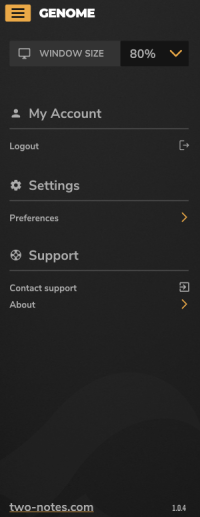 GENOME’s Hamburger Menu provides options for user preferences. licensing information and more. Open the Hamburger Menu by clicking the menu’s 3-dash icon to open the related pane and access the following preferences:
GENOME’s Hamburger Menu provides options for user preferences. licensing information and more. Open the Hamburger Menu by clicking the menu’s 3-dash icon to open the related pane and access the following preferences:
- WINDOW SIZE: Set the size of the plugin from 50% to 200%
- MY ACCOUNT: Access key information related to your account inclusive of Login and Logout functionality
- Settings: access the settings regarding the graphic animation for the Studio EQ, Studio Compressor
- SUPPORT: Submit a ticket to the Two notes Helpdesk and view information relating to the version of GENOME currently installed on your computer
1.2 Input Routing
In order to configure GENOME’s routing of the related input signal into the plugin, reveal the dropdown menu visible by clicking the icon next to ‘ IN’ located in the top left portion of GENOME’s Global Parameter Pane.
GENOME (v1.03) has been configured to process a stereo or a mono signal at its input stage and there are dedicated options to select how a Stereo signal is processed into a compatible Mono source. These are:
- Stereo: In this instance, the stereo signal at the input is processed in stereo by GENOME
- Mono LR Mix: In this instance both channels of the Stereo Signal are summed to a Mono Signal
- Mono from Left: In this instance GENOME processes the left channel of the Stereo Signal only
- Mono from Right: In this instance GENOME processes the right channel of the Stereo Signal only
Note: Users under GENOME (v1.02) do not have the Stereo option.
1.3 Input Meter & Input Level Fader
The Input Meter & Input Level Fader are located in GENOME’s Global Parameter Pane and provide quick access to manage the Input Level of your source audio. When configuring your Input Level, it is vital to ensure your source audio does not clip, subsequently driving the instantiated RIG’s Component configuration beyond optimal limits.
- Use the Input Level Fader to adjust the volume of your input signal by -12dB to +12dB. Ensure the Input Signal Level falls within a suitable range using the accompanying Input Meter to monitor the level at the source audio’s input into GENOME
- The optimal range for the input signal is -18dB to -6dB. If after setting the Input Level Fader, the the source audio’s Input Level registers outside of the optimal range, reduce the volume of the source audio’s signal before it reaches GENOME either on your audio interface (when direct monitoring) or via the Digital Audio Workstation’s audio editing preferences, insert utility plugin or similar (during playback)
Note: Within GENOME, internal signals are calculated in 32-bit float format; as such, signals can’t actually ‘clip’ inside GENOME as they might if using fixed 24-bit processing. However, maintaining an optimal volume range will ensure Components sensitive to input gain (Amplifiers/Distortion Pedals) operate within the volume range they were specified for.
Note: Post GENOME’s input, at a RIG/Component Level, the Output Level of each Component can be adjusted to ensure optimal inter-component gain staging.
1.4 TUNER
GENOME's TUNER is an accurate monophonic guitar and bass tuning utility located in GENOME’s Global Parameter Pane and is accessed by clicking on the Tuning Fork icon.
- Once instantiated the source input’s current pitch is indicated by the text note display; the accompanying graphic denotes how close the source audio is to the target semitone
- The reference pitch can be selected using the REFERENCE control in the range 432Hz to 448Hz, with 440Hz being the default standard tuning reference
- The OUTPUT switch located in the bottom right of the TUNER GUI determines whether the sound output is muted whilst tuning
- To close the TUNER window, click the 'X' located in the top right of the GUI
Note: TUNER parameters are not saved per RIG preset and exist as part of GENOME’s global parameter controls
1.5 NOISE GATE
GENOME’s NOISE GATE is a corrective utility located in GENOME’s Global Parameter Pane, instantiated and deactivated using the On/Off button to the right of the TUNER icon.
The NOISE GATE will lower the volume of the source signal below a designated input THRESHOLD, reducing any background noise present when not playing.
To reveal and edit the NOISE GATE settings, click the GATE button. To close the NOISE GATE settings either click the GATE button or click anywhere else on GENOME’s graphical user interface. The following parameters are available upon revealing GENOME’s NOISE GATE Settings:
- THRESHOLD: Sets a threshold level under which the NOISE GATE will activate
- HARD/SOFT: Sets the behavior of the NOISE GATE; HARD will cut the sound abruptly when the NOISE GATE is activated; SOFT apply a gentle roll-off to the gating effect
- LEARN: Clicking this button will enable the NOISE GATE’s LEARN Mode for automatic THRESHOLD configuration. When LEARN Mode is instantiated, stop playing and mute your strings; GENOME will then calculate the level of the background noise preset in the source signal and set the THRESHOLD accordingly
Note: The NOISE GATE is a global processor and as such is not saved per RIG
1.6 Output Meter & Output Level Fader
GENOME’s Output Meter & Output Level Fader are located in GENOME’s Global Parameter Pane, positioned next to the OUT moniker in the top right corner of the graphical user Interface.
GENOME’s Output Level can be adjusted using the Output Level Fader and monitored using the Output Meter to set a summative level at the output of the plugin. The Output Level Fader range is scaled from -95dB to 12dB. Use the Output Meter to monitor GENOME’s output signal level in real time post any adjustments made to the Output Level Fader.
Note: The Output Level Fader is a global processor and as such is not saved per RIG
1.7 CPU Meter & Oversampling
GENOME’s CPU Meter is located in GENOME’s Global Parameter Pane, positioned to the right of the Output Level Fader in the top right corner of the graphical user Interface. The CPU Meter provides an indication of how much CPU is used for the current loaded instance of GENOME.
Oversampling
GENOME’s Oversampling modes are located, selected and instantiated via the drop down menu above the CPU Meter. These modes allow the user to select the amount of Oversampling that is used within GENOME. Oversampling will reduce any audio anomalies (Aliasing) caused by frequency content in the processed signal above GENOME’s operating Sample Rate frequency. Higher Oversampling will increase GENOME’s effective Sample Rate to prevent any Aliasing, but will also increase CPU usage. For older computers it is recommended to use the OFF setting, as this is less CPU intensive. For more modern computers with faster CPUs, the choice of Oversampling can be made from all available options including OFF, HIGH, HIGH+, ULTRA, and MAX.
Ultra and MAX Oversampling modes are designed for offline rendering (bounce). These modes provide slight enhancements to audio quality at the cost of very high CPU usage. They are not fit for playback.
Note: The CPU Meter is not an indication of total CPU usage, but instead a meter showing how much CPU time is being used within the processing buffer for the currently active RIG and related components. As such, it will display a different value to a host- or system-centric CPU usage meter.
2. RIG Config Pane
The RIG Config Pane is located immediately under GENOME’s Global Parameter Pane, providing a suite of comprehensive RIG management facilities.
A note about GENOME RIGS: A GENOME RIG is a headline preset consisting of a pre-designated selection of Components organized across GENOME’s lane based architecture. Out-the-box, GENOME ships with an extensive selection of GENOME RIGS. Whether it’s a snarling lead tone or an ambient post-rock soundscape, GENOME’s RIGs are your fast track to tonal bliss.
2.1 RIG Select
To select a RIG, click the currently instantiated RIG name located in the top right of the RIG Config Pane. This will open GENOME’s RIG Browser where all available GENOME RIGs can be viewed, loaded and managed (see 2.2. RIG Browser)
To cycle through RIGs sequentially, use the Up/Down arrow positioned to the left of the GENOME RIG Select Window. This will load the previous/next RIG in the currently selected RIG Browser Bank respectively.
2.2 RIG Browser
The RIG Browser is accessed by clicking the RIG Select window within GENOME’s RIG Config Pane. This is a RIG management tool, allowing the user to Browse, Select, Save, Import and Export RIGs / RIG Banks. GENOME’s RIG Browser contains 8 Banks of RIGs with storage of up to 128 RIGs per bank. Within the RIG Browser, the following information and editable parameters are accessible to manage your library of GENOME RIGS:
- RIG Name: The RIG Name is shown at the top of the RIG Browser, displaying the name of the currently active RIG. If the name is followed by an asterisk ('*'), this notes that the RIG has been edited, and differs from the saved variant of the currently active RIG. To rename a RIG, either:
- Double-click the name at the top of the RIG Browser/RIG Select window and edit accordingly
- Or, hover over a RIG Preset in the RIG Browser, click the three horizontal dots on the right of the RIG Browser entry, and select 'Rename'
- Bank Search: RIGs be searched for by name within the currently selected Bank using the Search Box text entry field. The search results are updated in real-time as you type
- Bank Select: To choose current instantiated RIG Browser Bank, use the Bank A to H buttons located at the top of the RIG Browser
- Bank Import: To import an entire Bank, click the three dots to the right of the RIG Browser’s Bank Select, and choose 'Import File Over Bank'.
- Note: This will overwrite the current Bank; please save any RIGs you wish to keep prior to actioning a Bank Import
- Bank Export: To export an entire Bank, click the three dots to the right of the RIG Browser’s Bank Select, and choose 'Export Bank To File'. This will open a operating-system-specific file browser window, where a location can be selected on the host machine to save the entire instantiated Bank as a single .tnb GENOME RIG Bank file.
- Favorites: The RIG Browser’s Favorites feature allows you to flag your Favorite RIGs. To mark a RIG as a Favorite, click the Heart icon next to each RIG name, revealed when you hover over any RIG in the RIG Browser. To filter the RIG Browser RIG display to those marked as a 'Favorite', click the heart icon located at the top of the RIG Browser pane
- Delete RIG: To permanently delete a RIG, hover over the corresponding RIG slot in the RIG Browser, click the three dots located to the right of the RIG slot, and select 'Delete'
- Save RIG: To save a RIG to a slot in the RIG Browser, select a Bank, hover over a RIG slot, click the three dots within the corresponding RIG slot, and select 'Replace With Current Rig'
- RIG Export: To export a single RIG, click the three horizontal dots that appear when hovering over a RIG slot in the RIG Browser, and select 'Export'. This will open a operating-system-specific file browser window where a location can be selected on the host machine to save the RIG as a single .tnr RIG file.
- RIG Import: To import a single RIG, click on the three horizontal dots that appear when hovering over a RIG Slot in the RIG Browser, and select 'Import'. This will open a operating-system-specific file browser window for folder and file selection, alongside options to load a single .tnr RIG file into the current RIG slot
- Note: This will overwrite the current RIG Preset; please ensure the existing RIG is saved if you wish to keep this prior to actioning a RIG Import
2.3 RIG Revert, Save RIG, Undo/Redo
Within the RIG Config Pane, GENOME provides a suite of comprehensive tools to manage the instantiated RIG. These quick-access RIG Management Tools are positioned to the right of RIG Config Pane’s RIG Select tool and include the following options:
- Revert: To Revert an edited RIG to the saved variant of the RIG, click the RIG Revert icon
- Save RIG: Clicking the Save (Disk) icon saves the instantied RIG to the current RIG slot
- Undo / Redo: Virtually all editable RIG-centric actions are saved in GENOME’s Undo/Redo history. To Undo or Redo any modifications to the currently instantiated RIG, use these features to navigate back and forth through your edits
2.4 RIG Tempo
GENOME’s RIG Tempo is located in the top right of the RIG Config Pane, and displays the current BPM saved as part of the instantiated RIG. The ‘LOCK’ icon to the left of the RIG Tempo BPM Display provides the following options:
- Tempo From Rig: If selected, the RIG Tempo can be manually defined and edited by double-clicking in the BPM display
- In addition, if Tempo From Rig is selected, the RIG Tempo BPM can also be manually set by tapping the TAP button at the desired speed
- Tempo From Host: If selected, this BPM display is grayed out and uneditable; the RIG Tempo will subsequently match the BPM set within the host Digital Audio Workstation
Note: Where a GENOME component features a time-base parameter that can be synced to tempo-specific beat-divisions (e.g. STUDIO Modulation FX or the STUDIO Delay), any synchronization will be actioned in accordance with GENOME’s RIG Tempo.
3. RIG Builder
GENOME’s RIG Builder contains up to 20 effects slots (or Inserts'), each of which can be loaded with a GENOME Component. Within the RIG Builder, multiple components can be configured in Series or Parallel to create a RIG which in turn can be saved via GENOME’s RIG Browser (see section 2.2. RIG Browser).
3.1 Lane Architecture
GENOME’s RIG Builder harnesses a Lane Architecture with options to configure Dual Lanes for parallel processing and a Single Lane for series-based processing. Signal flow through GENOME’s Lane architecture is actioned from left to right; the left-most Insert takes its input from GENOME’s source, post the Input Level Fader; the right-most Insert outputs all processing from the instantiated RIG to the Output Level Fader before returning the signal to the Digital Audio Workstation.
3.2 Automatic Mono / Stereo Signal Flow Management
While GENOME’s source is always configured in Mono, Components within GENOME’s Component arsenal are classified as either Mono or Stereo processors; as such, a given Component will process the preceding audio at its input stage in accordance with it’s Mono or Stereo classification.
For the most part, the user cannot define whether a Component processes its input in Mono or Stereo however in some special cases, a Stereo Component can be forced to receive a Mono input (examples being the STUDIO Reverb and STUDIO Delay). For ease of use, GENOME will automatically manage Stereo/Mono routing within a RIG; lines connecting the Inserts will denote what type of connection has been configured.
- If an instantiated Component has a mono input, a single line will connect to the preceding Component/Insert
- If an instantiated Component has a Stereo input, a double line will connect to the preceding Component/Insert
Once a signal has been processed in Stereo, it will remain Stereo until it passes through a Component configured for a Mono input. Likewise, if a signal is Mono, it will remain Mono until it passes through a Component configured for a Stereo output.
3.3 Component Management
From adding new Components to moving Components within GENOME’s Lane based Architecture, Component Management has been configured as a hyper-intuitive process. Detailed below are the principal Component-management tools available when configuring a RIG.
3.4 Nodes
Hovering on any portion of GENOME’s Lane Architecture will reveal Nodes positioned between all qualifying Inserts. Nodes are used to configure GENOME’s Lane Split / Merge functionality detailed below.
GENOME’s Lane Split / Merge functionality allows for parallel processing within the GENOME RIG; for example, GENOME’s Lane Split / Merge can be configured to route amplifier and / or cabinet components in parallel, feeding a merged STUDIO FX chain in Series.
3.5 Splitting Lanes
To Split a Lane configured in series routing, click the Node between two target Inserts and select 'Split Here'. To move the Split junction, click on a different target Node and select 'Move Split Here'.
3.6 Merging Lanes
To Merge a Split configuration back into a single Lane for Series processing, click the Node between two Inserts anywhere after the Split junction and select 'Move Merge Here'.
Note: If a Merge junction has not been instantiated, the processed signal will always Merge after the last Insert, prior to the RIG output.
3.7 Lane Merge Mixer
At the Merge junction, the two parallel Lanes can be mixed using the Lane Merge Mixer. This can be accessed by clicking the Mixer icon shown at the Merge junction. The Lane Merge Mixer provides the following identical parameters for Lane A (the upper lane) and Lane B (the lower lane):
- Lane Mono/Stereo Routing: Defines the Stereo / Mono configuration of the respective Lane’s signal in accordance with the following options: Stereo, Mono LR Mix, Mono From Left or Mono From Right
- LEVEL: Sets the volume level of the respective Lane from -95dB to 12dB
- PAN: Sets the respective Lane’s pan value scaled from full left to full right
- MUTE: Provides controls to Mute/Unmute the Lane
- PHASE INVERT: Provides controls to Invert the Phase of the Lane
GENOME Components
1. Component Presets and Preset Management Common to All GENOME Components
Within GENOME, each Component includes a Component Module Preset Browser featuring an effect bypass/engage switch, a drop-down menu that lists any saved Presets, arrows that cycle through the component-level Presets, and an Import/Export option.
- To save a Preset, click the disk icon and enter a name for the Preset
- Hovering over each Preset in the drop-down menu will reveal three horizontal dots for quick access to a variety of Preset management tools; management options include moving the selected Preset up or down in the list, as well as facilities to replace, duplicate, rename or delete the selected Preset. The Preset can also be exported from this menu.
- To export the current Preset to a file on your host machine, click the three horizontal dots on the right of the Preset Browser
Component Output Level
Each Component in a GENOME RIG features a dedicated control for the OUTPUT LEVEL of the Component. This is positioned in the bottom right corner of the effects module’s Graphical User Interface. The Component Output Level can be used for volume compensation and inter-Component gain staging, setting the desired level of the processed signal prior to passing to the adjacent Component in the instantiated RIG.
Precision Parameter Control
When editing a parameter within a given GENOME Component, fine adjustment of the value can be achieved by holding CTRL (PC) / CMD (MAC) whilst dragging.
Parameter Reset
To reset a Component’s parameter to its default value, double-click the parameter name.
2. TSM™ Amplifiers
2.1 Foundry
Whether it’s a pristine high-headroom clean or a primo foundation for your pedal collection, Foundry delivers. In short, it’s the epitome of a classic Cali clean, brimming with warm saturation and engineered to capture every subtle nuance of your delivery.
2.2 Foundry Bass
Whether it’s a pristine clean or a primo foundation for your pedal collection, Foundry Bass delivers. In short, it’s the epitome of a classic Bass clean, brimming with warm saturation and engineered to capture every subtle nuance of your delivery.
2.3 Peggy
Bass players seeking the pinnacle in low-end theory, look no further than Peggy. Pushing complex harmonic overtones, a warm midrange and oodles of rafter ratlin’ thump, Peggy delivers the perfect blend of classic ’60s bass sonics with expertly-tuned tweak-ability to sit your tone in any pocket!
2.4 Albion
For those times when only a legendary Brit-inspired roar will suffice, there’s Albion. Complete with a rich, vocal mid-range, lashings of punch, boat-loads of power and gain-for-days, Albion is your secret weapon when diving head-first into Classic- and Hard-Rock territory.
2.5 ElDorado
Tight response? Check. Rich in harmonics? Check. Searing, perfectly balanced gain fused with lashings of sustain? Oh Yes! This really is a “triple threat” for the guitarist venturing into hard-rock and metal territory.
2.6 Foxy
Seeking chime, articulation and buttery-smooth presence? Foxy’s a one-stop-shop! With airy highs, impeccable breakup and sublime mid-range bite when pushing the gain, Foxy is primed to take on everything from sultry Jazz to rauch-fuelled Rock n’ Roll.
2.7 FlatBack
Looking for some Cali-born high-gain sonics, pushing the perfect combination of unrelenting power and deft levels of clarity? FlatBack’s a one-stop-shop offering lashings of harmonically rich overtones, a full bodied low-end and articulation for days!
2.8 Aviator
Looking for the epitome of a modern, forward-thinking bass tone? You owe it to your tone to check out Aviator. Whether it’s rafter-rattlin lows, or a high-gain onslaught fused with the all-important clarity your tone demands, this TSM™ Amplifier delivers on all counts!
2.9 NiftyFifty
Want gain? Nifty50’s got it on tap! It’s aggression incarnate. It’s punchy. It’s super-versatile covering everything from a warm full-throttle onslaught to a searing lead tone that cuts through any mix. Whether it’s the darker side of metal or a tone that wouldn’t be amiss in 80’s inspired virtuosity, Nifty50 is deserving of any contemporary player's sonic arsenal.
2.10 Gemini
For players seeking an alt slant on the iconic Bear-State clean, Gemini is just what the doctor ordered! At its core it delivers an articulate touch-sensitive sparkling-clean with oodles of warm breakup when pushed - in a nutshell, it’s contender #1 when it comes to getting the best from your overdrive pedal collection, lest we forget a dead-cert to pair with a vintage spring reverb for the epitome of a retro-inspired tone!
2.11 Tanger
When you’re in the market for sheer versatility - covering everything from a well-rounded articulate clean to a full-throttle high-gain onslaught - Tanger delivers on all counts! Fusing boat-loads of punch, lashings of sustain and a unique brit-inspired gain stage, Tanger ‘aint no one-trick-pony - it’s a powerhouse of tone primed for virtually any performance or recording scenario!
2.12 FlatBackFive
Looking for an alternate slant on Gold Coast high-gain sonics, complete with unrelenting gain, the perfect blend of relentless power and deft levels of precision? If the answer’s a resounding “YES”, then FlatBackFive is an absolute must-have!
2.13 Parameters Common to All TSM™ Amplifiers
The following parameters are available on all TSM™ Amplifier models:
INPUT (Preamp) Stage:
- GAIN: Sets the amount of input gain applied to the preamp stage. Higher settings will drive the input more, increasing the amount of PREAMP distortion. An additional method of adding more gain at the input is to increase the output volume of the previous component block.
- CHANNEL EQ: Each TSM™ Amplifier features a custom voiced 3-band Tone Stack, specific to the instantiated amplifier model
- BASS: Adjusts the level of bass frequency content for the selected model
- MID: Adjusts the level of mid frequency content for the selected model
- TREBLE: Adjusts the level of high frequency content for the selected model
POWERAMP Stage:
- DEPTH: Increasing this control adds more low frequency content to the POWERAMP stage
- CONTOUR: Low values result in reduced bass and treble frequency content creating a more 'mid-focussed’ tone; higher settings will increase the bass and treble frequency content while reducing mid-range frequencies resulting in a more 'scooped' sound
- VOLUME: Sets the tube output stage volume. As well as increasing the output volume, higher settings will also drive the output more, increasing the amount of POWERAMP distortion
- SETTINGS: Clicking the SETTINGS button will reveal the customisable POWERAMP SETTINGS pane complete with dedicated options for Tube Model, Type and Configuration. The following controls are available for surgical tuning of the selected POWERAMP’s tone:
- Tube Model: Choose between 6L6, EL34, EL84 & KT88 Tube Models
- Tube Configuration: Select whether the selected Tube Model is configured in SINGLE-ENDED or PUSH-PULL states
- Tube Type: Define whether the Tube model is a TRIODE- or PENTODE-centric emulation
3. STUDIO FX
3.1 DynIR Engine
Conquering the dividing line between sublime authenticity and uncompromising digital emulation, DynIR™ represents the pinnacle in virtual guitar- and bass-cabinet technology. Harnessing power equivalent to 160,000 studio- grade IR files, each Two notes DynIR™ can be shaped to the needs of even the most discerning tone chaser. With 8 mics per cabinet, dual mic-ing and 10K mic positions (front & back), unleashing your tone and finding your signature sound has never been simpler.
Top Tip: For optimal performance, the DynIR™ Engine should be placed post a TSM™ Amplifier or the CODEX Engine to recreate a typical guitar-centric signal chain.
The DynIR™ Engine’s GUI is divided up into four sections:
- Top Left: Cabinet Explorer/Selection
- Bottom Left: Microphone Controls (MIC A and MIC B)
- Central Pane (in-between the MIC A & MIC B channels): Global Controls
- Right: Cabinet & Microphone Interactive Mic’ing Quadrant
Cabinet Explorer/Selection: The Cabinet Explorer/Selection section is used to browse and select which DynIR™ Cabinet is loaded within the DynIR™ Engine. Within this section, the following controls are available:
- Text Search Box: The Text Search Box grants comprehensive searching facilities across Two notes’ extensive catalog of DynIR™ virtual cabinets, with the resulting Cabinet Explorer list being adjustable depending on the filtering criteria determined by the user. To remove the text search filter, click the red 'X' on the left of the box. The following filters are available to the user to refine the DynIR™ virtual cabinets shown within the Cabinet Explorer list:
- GUITAR/BASS Filter Switches: Selecting GUITAR or BASS limits the Cabinet Explorer list to DynIR™ virtual cabinets captured from either Guitar or Bass cabinets respectively
- Ownership Filter: Clicking the icon positioned to the right of the GUITAR/BASS Filter Switches toggles the 'Owned' filter - if instantiated/highlighted, the Cabinet Explorer will list any DynIR™ virtual cabinets not currently owned and therefore assigned to the user’s Two notes account ID; all non-owned cabinets shown within the Cabinet Explorer are available to demo and subsequently purchase. When in demo mode, only one microphone channel is available within the DynIR™ Engine’s GUI; in addition, GENOME will insert silence at random intervals until either an owned cabinet is instantiated and the demonstration mode exited, or the related cabinet is purchased from the Two notes store
- DynIR Cabinet Quantity Display: This is positioned To the right of the GUITAR/BASS Filter Switches and the Ownership Filter; here, a number is displayed indicating the quantity of DynIR™ virtual cabinets currently listed in the Cabinet Explorer
- Selected Cabinet Name Display Box: The currently instantiated DynIR™ virtual cabinet name is displayed in the Cabinet Name Display Box.
- Clicking in this box will reveal the Explorer/Browser window where cabinets can be selected based on SPEAKER SIZE, CAPTURE MASTER (the studio / party that created the capture), and OWNERSHIP (whether the license for the cabinet has been assigned to your Two notes account license)
- Note: This list will already be filtered by the GUITAR/BASS Filter, the Ownership Filter button, and any currently active Text Search
- Using the Explorer window, cabinets can be selected by highlighting a cabinet type in the left pane, and selecting a specific cabinet in the right pane
- The resultant cabinet list can be further refined by using the dedicated Sort Options positioned at the top of this Explorer/Browser window, either alphabetically (A-Z), by CAPTURE MASTER or by OWNERSHIP status
- The left/right arrows to the right of the Selected Cabinet Name Display Box cycle through all cabinets in the currently filtered list.
Microphone Controls (MIC A and MIC B): Each of the two microphones available to mic up the instantiated DynIR™ virtual cabinet share the same set of controls, located within the two Microphone Channels of the GENOME DynIR™ Engine component GUI; note that these controls are specific to each Microphone channel, both of which have been configured to operate independently from one another. The microphone controls common to the MIC A and MIC B channels are as follows:
- Microphone Type Drop-Down: Use this option to choose a Microphone for the selected Microphone channel from a list of eight microphones used to capture the instantiated DynIR™ virtual cabinet. Selecting 'Bypass' from this menu will remove any microphone-processing from this channel
- Microphone Channel Controls:
- DISTANCE: Adjusts the microphone distance from the speaker cabinet
- AXIS: Adjusts the microphone position; from on-axis (in the middle of the speaker cone), to off-axis (towards the edge of the speaker cone)
- Mute: The 'M' button mutes/unmutes the associated Microphone Channel
- Phase Invert: The “Ø” button inverts the phase of the associated microphone channel
- Microphone Volume Fader: Adjusts the selected Microphone Channel’s volume, from -inf to +12dB
- FRONT/BACK Selection: FRONT will place the mic in front of the cabinet, BACK will place the microphone at the rear of the cabinet
Global Controls:
- MIX: Adjusts the balance between the MIC A and MIC B Microphone Channels
- OVERLOAD: Simulates speaker cone break-up
- VARIPHI: The VARIPHI parameter is a one-of-a-kind control, exclusive to Two notes Torpedo and software ecosystem technology. It allows you to modify the frequency content of the signal, using the properties of the sum of two signals with different phase levels. Essentially, you emulate a situation where two microphones are used, and the VARIPHI parameter controls the distance (hence the phase relation) between the two microphones
Cabinet & Microphone Interactive Mic’ing Quadrant: The Cabinet & Microphone Interactive Mic’ing Quadrant permits placement of the instantiated microphones by dragging them within a pre-designated area relative to the selected cabinet’s speaker. When manually moving microphones in this manner, related parameters in the Microphone Controls (MIC A and MIC B) section will update accordingly.
- The selected microphones can be placed on- or off-axis, relative to the speaker
- The selected microphones can be moved away from the speaker to pick up more of the 'room' sound
- A 'Speaker Aim Assist' ('+' sign) is displayed on the cabinet grill to aid with microphone axis positioning when the selected microphones are being placed within the mic’ing quadrant
- Holding CMD (Mac) / CTRL (PC) while dragging allows for refined positioning with a greater degree of clinical accuracy
- If the microphone you wish to select is 'hidden' by the companion microphone, use the MIC A or MIC B buttons in the Microphone Controls (MIC A and MIC B) section to instantiate it
- At the bottom right of the DynIR™ Engine’s GUI, a FRONT/BACK selector allows the cabinet to be viewed from the front or back facilitating microphone placement in front or behind the cabinet respectively
3.2 IR Loader
Purpose engineered to load static cabinet IR files - and featuring capacity for 2 static IRs per component instance - the IR loader is primed to load and adapt all your Mono or Stereo .wav, .aiff and .tur files to perfection. Some key features of the IR Loader include:
- Up to two IRs can be loaded in each IR Loader component, edited, and the resulting Output IR used in your RIG
- Loaded IRs can be up to 2 seconds in length. If the IR File is over 2 seconds, the file will be automatically truncated to 2 seconds
- Supported File Formats are .wav, .aiff and .tur files; these can be Mono or Stereo, and can also exhibit different sample rates or bit depths to the current project settings
IR Browser and Selection:
- To select the folder on your host computer’s file system where your IRs are stored, use the Folder icon and navigate to the desired location
- Once a folder has been selected, the left/right buttons will cycle through the IRs in that folder
- The name of the currently loaded IR file is displayed in the IR File Name Text Box
- Clicking the IR File Name Text Box will bring up a drop-down menu where individual IRs can also be selected and loaded
- When an IR is loaded, the Waveform/Info Window displays the IR alongside the specifications of the instantiated IR file
IR Editing Controls: For each IR Channel (IR A and IR B), the following controls are available:
- MUTE: The 'M' button mutes/unmutes the related IR Channel
- PHASE INVERSION: The Ø button inverts the phase of the IR Channel when engaged
- VOLUME: Adjusts IR Channel volume, from -95dB to +12dB
Global Controls: The following global controls are available, affecting but the IR A and IR B channels:
- MIX: Adjusts the balance between the IR A and IR B channels
- OVERLOAD: Simulates speaker cone break-up.
- VARIPHI: The VARIPHI parameter is a one-of-a-kind control, exclusive to Two notes Torpedo and software ecosystem technology. It allows you to modify the frequency content of the signal, using the properties of the sum of two signals with different phase levels. Essentially, you emulate a situation where two microphones are used, and the VARIPHI parameter controls the distance (hence the phase relation) between the two microphones
FX Options Submenu: Further controls are available from the FX Options Submenu Icon in the top right of the GUI:
- ALIGN MODE: The following controls are available:
- NONE: The IR file is processed without changes
- MIN PHASE: The IR files are automatically configured to be in phase with one another
- MIN LATENCY: The IR files are placed to generate the minimum possible latency
- TIME UNIT: The following controls are available:
- MILLISECONDS: Selects whether the IR length should be displayed in milliseconds in the Waveform/Info Window
- SAMPLES: Selects if the IR length should be displayed as a number of samples in the Waveform/Info Window
3.3 STUDIO Delay
The STUDIO Delay is a pro-grade STUDIO FX component developed by Two notes Audio Engineering for use exclusively within GENOME. Fusing dual-channel (stereo/dual-mono) operation, tempo-synced & free-form delay times, comprehensive channel link facilities, dedicated channel filters and every mainstay you would expect from a studio-grade delay, creating anything from an ambient post-rock delay bed to a mix-cuttin’ slapback is ripe and ready for the taking.
The A Channel and B Channel both share the same arsenal of controls; these can be linked together using the LINK switches located in the central pane of the STUDIO Delay’s GUI under the TIME, FEEDBACK, DRY / WET & EQ labels.
The A- and B-Channel’s delay times can be manually adjusted in milliseconds, or can be synced to the current RIG tempo. In addition, HIGH CUT and LOW CUT filters can be engaged to alter the tone of the repeats as they decay.
Note: The input to the STUDIO Delay Component can be either mono or stereo; to configure this, click the three dots in the Preset Browser at the bottom of the GUI, and select the Wet Summing option. For more details on the STUDIO Delay’s Preset Browser, please refer to “Component Presets and Preset Management Common to All GENOME Components”
Controls common to both the A- and B-Channels:
- ON: Sets whether the related channel is bypassed or engaged
- TIME: Sets the delay time, either in ms, or subdivisions of the beat, depending on the mode selected:
- ms Mode: Manually sets the delay time from 1ms - 8000ms
- Note Mode: Sets the delay time to subdivisions of the beat from 1/64 to 8/1
- Dot Mode: Sets the delay time to dotted subdivisions of the beat from 1/64d to 8/1d
- Trip Mode: Sets the delay time to triplet subdivisions of the beat from 1/64t to 8/1t
- TAP: When in ms Mode, this can be used to set the delay time manually by tapping at the desired speed
- FEEDBACK: Controls the number of delay repeats, or the 'regeneration' amount
- PAN: Sets the pan position of the channel's delayed signal
- DRY / WET: Controls the volume of the delayed signal relative to the input signal
- LOW CUT: Sets the frequency of the LOW CUT filter that is in the delay loop from 10Hz to 5kHz
- HIGH CUT: Sets the frequency of the HIGH CUT filter that is in the delay loop from 100Hz to 20kHz
- SLOPE: Alters the steepness of both the HIGH CUT and LOW CUT filters, allowing for different tonal options
3.4 STUDIO Reverb
The STUDIO Reverb is a pro-grade STUDIO FX component developed by Two notes Audio Engineering for use exclusively within GENOME. Combining every mainstay control you demand from a studio verb, with an easy-to-use interface for expert-level tone-shaping, the STUDIO Reverb is primed for everything from an expansive cloud-like wash to a hyper-accurate room simulation.
GENOME's STUDIO Reverb provides extensive control over both the TAIL and EARLY REFLECTIONS via the dedicated editing panes in the STUDIO Reverb’s GUI (for more information, please see below). For rapid setting of the overall Reverb length - via simultaneous adjustment of the EARLY REFLECTIONS, PREDELAY and TAIL - a handy SIZE parameter is available to expand and contract all noted Reverb lengths at the same time.
Note: The input to the STUDIO Reverb Component can be either mono or stereo; to configure this, click the three dots in the Preset Browser at the bottom of the GUI, and select the Wet Summing option. For more details on the STUDIO Reverb’s Preset Browser, please refer to “Component Presets and Preset Management Common to All GENOME Components”
The interface is split into four main areas:
- Top Left Pane: Early Reflections
- Bottom Left Pane: Reverb Tail
- Right Pane: Post-Reverb EQ
- Middle Pane: Global Controls
Early Reflections:
- AMOUNT (0 - 100): Sets the volume of the early reflections
- SPREAD (0 - 100): Sets the time spacing between reflections, or the 'room size'
- DAMPING (0 - 100): Sets the Early Reflection high frequency damping, affecting the 'color' of the room from bright to dull
Reverb Tail:
- PREDELAY (0 - 250ms): Sets the time delay before the reverb tail starts
- DECAY (0.1 - 100secs): Sets the decay time of the Reverb Tail
- DIFFUSION (0 - 100): Sets the 'smearing' of the reverb tail, where higher settings make the reverb more diffuse
- TONE (-100 - +100): Controls the high frequency damping, allowing spaces that feel brighter or darker
Post-Reverb EQ:
- LOW FREQ (20hz - 20kHz): Sets the frequency of the Low Shelf Filter
- HIGH FREQ (20hz - 20kHz): Sets the frequency of the High Shelf Filter
- LOW GAIN (-24 - 24dB): Sets the level of gain applied to the Low Shelf Filter
- HIGH GAIN (-24 - 24dB): Sets the level of gain applied to the High Shelf Filter
Global:
- DRY / WET (0 - 100): Sets the balance between DRY and WET signals
- WIDTH (0 - 100): Sets the stereo WIDTH of the overall Reverb, from Mono to full Stereo
- REVERB SIZE (0.1 - 2.0): Simultaneously expands or contracts the three time-based controls (SPREAD, PREDELAY, DECAY) to adjust the overall length of the Reverb
3.5 STUDIO Chorus
In the market for a rich, liquid tone fused with fuss free operation? The STUDIO Chorus is a one-stop-shop! Whether it’s a smooth, subtle modulation or a dramatic contemporary ensemble with lashings of width, this GENOME component delivers everything you need in a format that keeps you focussed on your all-important performance!
Within the STUDIO Chorus, the following parameters are available to configure the Chorus effect:
- SPEED: Determines the speed of the modulation in either Hertz or beat subdivisions depending on the mode selected:
- Hz Mode: Allows manual control of the modulation speed from 0.03Hz to 5Hz
- Note Mode: Sets the modulation speed to subdivisions of the beat from 1/64 to 8/1
- Dot Mode: Sets the modulation speed to dotted subdivisions of the beat from 1/64d to 8/1d
- Trip Mode: Sets the modulation speed to triplet subdivisions of the beat from 1/64t to 8/1t
- FEEDBACK: Sets the 'Regeneration' amount that adds resonance to the modulation effect
- DRY / WET: Controls the volume of the Chorus effect relative to the input signal
- AMOUNT: Sets the range of the modulation, with higher settings sweeping the modulation over a greater range
- WIDTH: Adjusts the stereo width of the Chorus effect
3.6 STUDIO Vibrato
Want to add a touch of vibrato to your tone fast? The STUDIO Vibrato delivers on all counts! With an elegant 3-parameter operation, expertly-tuned to deliver contemporary and traditional modulations alike, the STUDIO Vibrato is a guaranteed final destination and a must-have in the modern guitarist’s sonic arsenal.
Within the STUDIO Vibrato, the following parameters are available to configure the Vibrato effect:
- SPEED: Determines the speed of the modulation in either Hertz or beat subdivisions depending on the mode selected:
- Hz Mode: Allows manual control of the modulation speed from 0.1Hz to 10Hz
- Note Mode: Sets the modulation speed to subdivisions of the beat from 1/64 to 8/1
- Dot Mode: Sets the modulation speed to dotted subdivisions of the beat from 1/64d to 8/1d
- Trip Mode: Sets the modulation speed to triplet subdivisions of the beat from 1/64t to 8/1t
- AMOUNT: Sets the range of the modulation, with higher settings modulating the pitch over a greater range. The maximum pitch variation is approximately 1 semitone
- WIDTH: Adjusts the stereo width of the pitch modulation, where higher settings vary the pitch more on one side of the stereo field than the other
3.7 STUDIO Tremolo
Fusing Dynamic or Harmonic operation with every must-have control you demand, the STUDIO Tremolo is perfect for adding everything from 60’s surf-fuelled vibe to a hard cutting effect giving edge and definition to sustained chords. For comprehensive control, the speed of the STUDIO Tremolo can be adjusted manually or sync'ed to the RIG tempo.
Within the STUDIO Tremolo, the following parameters are available to configure the Tremolo effect:
- SPEED: Determines the speed of the modulation in either Hertz or beat subdivisions depending on the mode selected:
- Hz Mode: Allows manual control of the modulation speed from 0.1Hz to 20Hz
- Note Mode: Sets the modulation speed to subdivisions of the beat from 1/64 to 8/1
- Dot Mode: Sets the modulation speed to dotted subdivisions of the beat from 1/64d to 8/1d
- Trip Mode: Sets the modulation speed to triplet subdivisions of the beat from 1/64t to 8/1t
- AMOUNT: Sets the scale of the modulation, with higher settings modulating the volume or harmonic content over a greater range
- MODE: There are two principal modes of operation available:
- Harmonic: Provides modulation of harmonic distortion within the processed signal
- Dynamic: Provides modulation of volume only
3.8 STUDIO Phaser
Featuring selectable 6-stage operation and every mainstay demanded from a studio-grade phaser, the STUDIO Phaser component delivers everything from a subtle enhancing drift to a full-throttle ultra-wide stereo lead that guarantees a veritable fog of distinction.
Within the STUDIO Phaser, the following parameters are available to configure the Phaser effect:.
- SPEED: Determines the speed of the modulation in either Hertz or beat subdivisions, depending on the mode selected:
- Hz Mode: Allows manual control of the modulation speed from 0.03Hz to 10Hz
- Note Mode: Sets the modulation speed to subdivisions of the beat from 1/64 to 8/1
- Dot Mode: Sets the modulation speed to dotted subdivisions of the beat from 1/64d to 8/1d
- Trip Mode: Sets the modulation speed to triplet subdivisions of the beat from 1/64t to 8/1t
- FEEDBACK: Sets the 'Regeneration' amount that adds resonance to the modulated signal
- DRY / WET: Controls the volume of the modulated signal relative to the input signal
- AMOUNT: Sets the scale of the modulation, with higher settings sweeping the phaser over a greater range
- WIDTH: Adjusts the stereo width of the phasing effect
- COLOR: Sets the center tone of the modulation, adjusting the frequency range over which the phaser is active
- STAGES: Sets the number of phasing stages from 1 to 6
3.9 STUDIO Flanger
From a mix-ready stereo sweetening effect brimming with subtle modulations to the most contemporary extreme flanging effects, the STUDIO Flanger with its raft of essential controls delivers on any - and every Flanger-centric need.
Within the STUDIO Flanger, the following parameters are available to configure the Flanging effect:.
- SPEED: Determines the speed of the modulation in either Hertz or beat subdivisions, depending on the mode selected:
- Hz Mode: Allows manual control of the modulation speed from 0.03Hz to 10Hz
- Note Mode: Sets the modulation speed to subdivisions of the beat from 1/64 to 8/1
- Dot Mode: Sets the modulation speed to dotted subdivisions of the beat from 1/64d to 8/1d
- Trip Mode: Sets the modulation speed to triplet subdivisions of the beat from 1/64t to 8/1t
- FEEDBACK: Sets the 'Regeneration' amount that adds resonance to the modulated signal
- SYNC / OPPOSITE: Sets the Stereo operation mode of the STUDIO Flanger:
- SYNC Mode: Both left and right channels sweep up and down together
- OPPOSITE Mode: One Stereo Channel sweeps up when the other Channel sweeps down
- DRY / WET: Controls the volume of the Flanger effect relative to the input signal
- AMOUNT: Sets the scale of the modulation, with higher settings sweeping the flanger over a greater range
- WIDTH: Adjusts the stereo width of the Flanging effect
- COLOR: Sets the center tone of the modulation, adjusting the frequency range over which the Flanger is active
3.10 TSM™ Power Amp
GENOME's Tube Stage Modelling Power (TSM™) Amplifier component is a pro-grade customisable power amplifier emulation. Using our proprietary TSM™ technology, dive in and sculpt your tone with 4 separate tube models (6L6, EL34, EL84 and KT88) in Push- Pull / AB class, or Single Ended / A class configurations. In a nutshell, it’s everything you need to tweak to your heart’s content and enrich your tone with the undeniable mojo of an authentic clipping/compressed power section.
Note: The TSM™ Power Amp component does not feature a preamp or tone stack, and as such should be placed post a suitable preamp component or DI feed for optimal results.
Within the TSM™ Power Amp, the following parameters are available to configure the Power Amp Emulation:
- TUBE MODEL: Choose between 6L6, EL34, EL84 & KT88 Tube Models
- DEPTH: Increasing this control adds more low frequency content to the POWERAMP stage
- CONTOUR: Low values result in reduced bass and treble frequency content creating a more 'mid-focussed’ tone; higher settings will increase the bass and treble frequency content while reducing mid-range frequencies resulting in a more 'scooped' sound
- VOLUME: Sets the tube output stage volume. As well as increasing the output volume, higher settings will also drive the output more, increasing the amount of POWERAMP distortion
- Tube Configuration: Select whether the selected Tube Model is configured in SINGLE-ENDED or PUSH-PULL states
- Tube Type: Define whether the Tube model is a TRIODE- or PENTODE-centric emulation
Note: In the preset browser section, clicking the three dots on the right hand side of the pane provides options for the TSM™ Power Amp’s Processing Mode. This feature is principally included for preset compatibility with Wall Of Sound; the Wall Of Sound option will switch the Power Amp component into a legacy mode, faithfully replicating the tonality and control specification of the Power Amp component included in Two notes’ Wall of Sound plugin. When the GENOME mode is instantiated, expect an updated tonal output when adjusting DEPTH, CONTOUR and VOLUME parameters.
3.11 CODEX
CODEX is a next-gen unification engine, primed to unleash the full-potential of your AI-powered amp & pedal capture arsenal. Featuring complete-compatibility with Neural Amp Modeller (NAM), AIDA-X and Proteus / Proteus Knob captures captures, CODEX delivers a suite of custom-engineered FX to surgically adapt and reimagine any static AI model to your exacting needs.
Within CODEX, the following parameters are available to configure the component:
- Input Source Configuration: Use this drop-down selector to determine whether CODEX is fed by a Stereo or Mono source; the following options are available:
- Stereo: In this instance, CODEX is fed with a Stereo Signal and will always process two channels of audio; note that this will effectively increase the host machine’s CPU load and should only be used when front-loading CODEX with Stereo effects and processors
- Mono LR Mix: In this instance both channels of the Stereo Signal are summed to a Mono Signal
- Mono from Left: In this instance CODEX processes the left channel of the Stereo Signal only
- Mono from Right: In this instance CODEX processes the right channel of the Stereo Signal only
- File Browser: Use the File Browser to select the folder on your computer’s file system where your compatible AI Amp and Pedal capture files are stored: click the Folder icon, navigate to the desired folder on your host machine's hard-drive and select a compatible file. Once a folder has been selected, the left/right buttons will cycle through the AI Amp and Pedal capture files stored in that folder. The name of the currently loaded AI Amp and Pedal capture is displayed in the File Name Text Box located at the top left of the GUI. Clicking the File Name Text Box will open a drop-down menu where individual AI Amp and Pedal capture profiles can be selected and loaded.
- INPUT Section: When configuring the input stage of CODEX, the following controls are available:
- Input Voicing: A fixed EQ setting to optimize the input to the AI Amp and Pedal capture profile - available options include WARM, NEUTRAL and BRIGHT. This control offers a fast and effective solution to the common pitfall of amp sims often sounding too muddy or too harsh depending on the personal taste of the player. Comprising a simple 2 band EQ + gain compensation, the selected input voicing ensures AI Amp and Pedal capture profiles react in accordance with what the guitar player generally enjoys in terms of tightness/fullness
- GAIN: Adjusts the input gain to the AI Amp and Pedal capture, affecting the volume and subsequent drive of the instantiated profile
- Note: The range of the GAIN control varies depending on the compatible file format loaded. This has been configured to ensure optimal sound for the capture profile instantiated and maintain an input signal within an ideal range
- TONESTACK: CODEX’s TONESTACK emulates a variety of real-world Tone Stacks modeled from classic amplifier tone circuits. Depending on the TONESTACK selected, up to four EQ-centric Tone Stack controls operate at different frequencies. When configuring CODEX’s TONESTACK, the following controls are available:
- Off/On Switch: Accessible via the top left corner of the TONESTACK section to bypass/engage the TONESTACK processing
- Tonestack Type: Use this selection box to determine the TONESTACK model to add to the AI Amp and Pedal capture
- PRE/POST: Use this to position the selected TONESTACK at different points in the signal chain:
- If PRE is selected, the routing is configured as follows: Input Signal > TONESTACK > Gain > Input Voicing > Amp Model > Output > EQ > Enhancer
- If POST is selected, the routing is configured as follows: Input Signal > Gain > Input Voicing > Amp Model > TONESTACK > Output > EQ > Enhancer
- BASS: Use this control to attenuate or boost the Bass frequency content of your signal of the instantiated AI Amp or Pedal capture profile
- MID: Use this control to attenuate or boost the Mid-Range frequency content of your signal of the instantiated AI Amp or Pedal capture profile
- TREBLE: Use this control to attenuate or boost the Treble frequency content of your signal of the instantiated AI Amp or Pedal capture profile
- Note: If a TONESTACK type features a different number of tone controls than those listed above, only those controls will be visible and labeled accordingly
- OUTPUT Section: The following controls are available:
- VOLUME: Adjusts the OUTPUT VOLUME of the instantiated AI Amp or Pedal capture profile
- EQ Section: Use the 5-band Graphic Equalizer to further refine the instantiated AI Amp or Pedal capture profile. Within the Graphic Equalizer, the following controls are available:
- Off/On Switch: Located in the top left corner of the EQ section, this can be used to bypass/engage the EQ section.
- EQ Controls:
- GUITAR/BASS/CUSTOM Mode: Choosing GUITAR or BASS mode selects fixed frequency bands optimized for guitar or bass respectively; selecting CUSTOM allows the user to manually configure the specified frequencies for each band
- LOW CUT: Determines the frequency at which the LOW CUT Filter is applied
- HIGH CUT: Determines the frequency at which the HIGH CUT Filter is applied
- 5-Band Graphic EQ: Depending on the mode chosen, each of the 5 bands operates at a particular frequency, with a range of +/-20dB
- In GUITAR Mode: The frequencies are fixed at 120Hz, 360Hz, 800Hz, 2kHz and 6kHz
- In BASS Mode: The frequencies are fixed at 50Hz, 120Hz, 360Hz, 800Hz and 4kHz
- In CUSTOM Mode: The frequency of each band can be adjusted using the dedicated FREQUENCY controls that appear below the vertical sliders
- ENHANCER: CODEX’s ENHANCER is a tone-shaping tool that can be used to boost the signal-content of the AI Amp or Pedal capture profile via three pre-designated frequency bands - low, mid and high. This works somewhat like an EQ, but adds a degree of compression to each of the aforementioned bands. The ENHANCER is placed at the end of the signal chain and features the following controls to refine the output of the instatied AI Amp or Pedal capture profile:
- Off/On Switch: Located in the top left corner of the ENHANCER section, use this to bypass/engage the ENHANCER
- ENHANCER Controls:
- GUITAR/BASS: Switch to select whether the ENHANCER’s Frequency Bands are optimized for Guitar or Bass
- DRY / WET: Sets the volume of the affected signal relative to the input signal
- BODY: Sets the amount of processing applied by the ENHANCER to the mid-range frequency content
- THICKNESS: Sets the amount of processing applied by the ENHANCER to the low-end frequency content
- BRILLIANCE: Sets the amount of processing applied by the ENHANCER to the high-end frequency content
3.11.1 Securing additional CODEX Captures
CODEX is compatible with Neural Amp Modeller (NAM), AIDA-X and Proteus captures. We'd like to take this opportunity to thank the teams at Mod Audio, Guitar ML, Amalgam Audio and Tone Hunt veteran Arlington Audio / Nathan Mesiti for supplying our stock captures! Need more captures? We’ve included some quick links below for your perusal:
Neural Amp Modeller (NAM)
- Get more information on NAM: https://www.neuralampmodeler.com/
- Discover ToneHunt: https://tonehunt.org/
- Check out Nathan Mesiti’s Captures: https://tonehunt.org/ArlingtonAudio
Mod Audio / AIDA-X
- Get more information on AIDA-X: https://aida-x.cc/
Guitar ML / Proteus:
- Get more information on Proteus: https://guitarml.com/
- Go Support Proteus: https://www.patreon.com/GuitarML
- Follow Proteus: https://www.youtube.com/@GuitarML
Amalgam Audio:
- Get more information on Amalgam Audio: https://www.amalgamcaptures.com/
3.12 STUDIO EQ
Featuring up-to 16 bands of operation, an intuitive layout complete with a visual analysis engine, band-isolate functionality and every main-stay control you would expect from a pro-grade parametric equalizer, the STUDIO EQ covers all your creative and corrective needs, whether it’s the all-important mixdown or honing the perfect live tone.
The STUDIO EQ is divided into 2 principal sections:
- The Graphical User Interface featuring an editable EQ curve defined per instantiated band and backed by a visual analysis engine
- The Control Pane featuring parameters to add / remove bands and dedicated controls to surgically configure each EQ band
Top Tip: Many of the controls in the Control Pane of the STUDIO EQ can also be adjusted by clicking on the EQ nodes in the Graphical User Interface.
Within the STUDIO EQ, the following configuration options are available:
Adding or Removing EQ Bands:
- In the Control Pane, a band can be added using the '+' button, and deleted using the 'X' button
- In the Graphical User Interface, a band can be added by double-clicking and deleted by double-clicking the EQ node while holding the CTRL Key (PC) or CMD Key (MAC)
Selecting EQ Bands:
- In the Control Pane, a band can be selected by using the left/right arrows to cycle through the instantiated bands, or by clicking on the Band Number and using the related drop-down menu
- In the Graphical User Interface, a band can be selected by clicking on the desired EQ node
Enabling/Disabling EQ Bands:
- In the Control Pane, a band can be enabled or disabled using the On/Off button located in the bottom left of the pane
- In the Graphical User Interface, a band can be enabled or disabled by double-clicking on the EQ node
EQ TYPE:
- To change the EQ type for a specific band, click in the EQ type box located in the Control Pane and select the desired band from the resultant drop-down menu
- The available EQ types include: Peak, Notch, Low-Cut, High-Cut, Band-Pass, Low-Shelf & High-Shelf
GAIN:
- The GAIN applied to each band can be adjusted in either the Control Pane, or by clicking and dragging each EQ node up or down within the Graphical User Interface
- The GAIN parameter is only active on the following EQ types: Peak, Low-Shelf, High-Shelf
- To ensure only GAIN is altered and not the frequency setting of the selected node, hold CTRL (PC) or CMD (MAC) whilst dragging the related node
FREQUENCY:
- The center frequency of each band can be adjusted in the Control Pane or by clicking and dragging each EQ node left or right within the Graphical User Interface
- To ensure only FREQUENCY is altered and not the GAIN of the selected node, hold ALT (PC) / Option (MAC) whilst dragging
Q
- The Q factor, or 'width' of each node’s band can be adjusted in the Control Pane
- Note: Q values are centered around 0.707 but ranges have been tweaked for each EQ type to be musically pleasing; as such, duplicating settings from another EQ plug-in may not garner desired results
SLOPE
- The SLOPE of the selected band can be adjusted via the dedicated control located within the right hand side of the Control Pane; use either the left/right arrows or click the SLOPE text box to reveal the related drop-down menu
- In most instances, SLOPE affects the 'order' (or 'steepness') of the band from the center frequency
- Note: When using the Peak EQ TYPE, a SLOPE value other than 12dB/oct will transform the Peak EQ TYPE into a Band-Shelf EQ TYPE; in this instance, the Q parameter will control the bandwidth of the Band Shelf
3.13 STUDIO Compressor
When it comes to surgical dynamic control, a full-featured Compressor is a certified must-have. Complete with every mainstay control demanded from a pro-grade compressor - plus lookahead and an ultra-intuitive visual analysis engine - the STUDIO Compressor is a one-stop-shop when it comes to complete control over your source signal’s dynamic content.
Within the STUDIO Compressor, the following parameters are available to configure the component:
- ATTACK: Sets the attack time from 1ms to 200ms
- RELEASE: Sets the release time from 10ms to 500ms
- KNEE: Sets the sharpness of the compression curve. A “Soft” KNEE will react to lower signal levels in and around the THRESHOLD level to a moderate degree, whereas a “Hard” KNEE will only ever compress signal levels above the THRESHOLD
- Note: This setting can also be controlled using the horizontal handles located in the Compression Curve Graphic
- RATIO: Sets the compression ratio from 1:1 (no compression) to 100:1 (limiting). This setting can also be controlled using the rightmost handle in the Compression Curve Graphic
- THRESHOLD: Sets the input level in dB required to trigger compression. This setting can also be controlled using the central handle in the Compression Curve Graphic
- MAKE-UP: Sets a level of Gain make-up to compensate for level reduction caused by the component’s compression amount
- HP FILTER: Sets the STUDIO Compressor’s Sidechain High-Pass frequency in Hz. Frequencies below this value will not trigger compression
- LOOKAHEAD: Sets the LOOKAHEAD from 0ms to 10ms. This parameter forward-analyses signal content resulting in quicker reaction to peaks in the audio signal
- Note: Using LOOKAHEAD will add latency equal to the lookahead time
- DRY / WET: Controls the volume of the compressed signal relative to the input signal, ideal for implementing 'parallel compression' techniques
- UNLINKED/LINKED: Use these options to determine how the STUDIO Compressor reacts to Stereo Signals:
- LINKED: Maintains compression for both Left and Right channels regardless of differentials between each channel within the Stereo signal
- UNLINKED: Configures the STUDIO Compressor to compress Left and Right channels separately and independently
- PEAK/RMS: Determines the mode for the STUDIO Compressor’s signal detection:
- PEAK: The compressor will be configured to engage on shorter peaks
- RMS: The compressor will be configured to engage based on an averaged input signal over time
3.14 STUDIO Enhancer
When it comes to tone, primo dynamic- and tone-shaping tools are a certified must-have. Enter GENOME’s STUDIO Enhancer. Complete with ‘Thickness’ and ‘Brilliance’ controls to emphasize the low- and high-end sonic content of your DI signal respectively - plus a super-handy ‘Body’ encoder to dial in a fuller, more present tone - and all rudiments are well-and-truly set to push meteoric sonics whatever your next performance demands.
Within the STUDIO Enhancer, the following parameters are available to configure the component:
- DRY / WET: Sets the volume of the affected signal relative to the input signal
- BODY: Determines the mid-range frequency enhancement amount
- THICKNESS: Determines the low-end frequency enhancement amount
- BRILLIANCE: Determines the high-end frequency enhancement amount
- OFF/ON: Sets whether the component is bypassed or engaged
- GUITAR/BASS: Determines whether the frequencies affected are optimized for guitar or bass respectively
3.15 STUDIO Twin Tracker
Seeking a radical stereo makeover? Meet GENOME’s TWIN TRACKER - a cutting-edge stereo double tracking wunderkind. Simply fire-it-up to create a proxy - or ‘Virtual Guitarist’ - on the right channel in real-time!
Note: The STUDIO Twin Tracker component will always sum the input to mono, even if it is fed with a stereo signal.
Within the STUDIO Twin Tracker, the following parameters are available to configure the component:
- BALANCE: Determines the position of the affected and source signal within the stereo field
- TIGHTNESS: Controls the level of synchronization/drift of the proxy as well as width of the source- and affected-signal within the Stereo field; higher values for this parameter result in a more extreme double-tracking effect
- OFF/ON: Sets whether the component is bypassed or engaged
3.16 STUDIO Exciter
Looking to add some low end definition or top-end sizzle to your tone? The STUDIO Exciter is just what the doctor ordered. Fusing a fuss-free interface and an expertly-tuned algorithm, the STUDIO Exciter guarantees to get your tone where you need it fast. The result? You spend less time tweaking and more time on the important business of playing!
Note: The STUDIO Exciter operates somewhat like an EQ; however, instead of boosting frequencies, it adds harmonic content relative to the original signal to predesignated processing bands.
Within the STUDIO Exciter, the following parameters are available to configure the component:
- LOW: Sets the low frequency excitation amount
- HIGH: Sets the high frequency excitation amount
- OUT: Sets whether the component is bypassed or engaged
3.17 Wall of Sound Post FX
For our legion of Wall of Sound users, we’ve engineered a specific component that replicates the Post FX suite included in industry standard poweramp modelling, cabinet emulation and virtual mic’ing plugin.
Note: Presets created in Wall of Sound can be imported into GENOME. Preset import is limited in that only the first two DynIR Virtual Cabinets used in the target Wall of Sound preset will be ported into the respective GENOME preset. Upon importing the Wall of Sound preset, multiple qualifying component blocks will be added to the GENOME RIG to recreate the complete Wall of Sound preset.
EQ Section
The Wall of Sound Post FX Component features a Graphic Equalizer to refine your tone by increasing/decreasing the level of specific pre-defined frequencies. Within the Graphic Equalizer, the following controls are available:
- Off/On Switch: This can be used to Bypass/Engage the EQ section
- GUITAR/BASS/CUSTOM Mode: Choosing the GUITAR or BASS Mode selects fixed frequency bands optimized for guitar or bass respectively. Selecting the CUSTOM Mode allows the user to manually configure the specified frequencies for each band. Each Mode features a HIGH CUT filter that can be adjusted to remove all frequencies below the HIGH CUT filter frequency. Depending on the Mode selected, each of the bands operates at a particular frequency, with a range of +/-20dB; Each frequency band can also be bypassed/enabled using the Off/On buttons above each band slider:
- In GUITAR Mode: The band frequencies are fixed at 120Hz, 360Hz, 800Hz, 2kHz and 6kHz. The HIGH CUT can be set between 10Hz and 500Hz
- In BASS Mode: The band frequencies are fixed at 50Hz, 120Hz, 360Hz, 800Hz and 4kHz. The HIGH CUT can be set between 10Hz and 500Hz
- In CUSTOM Mode: The Frequency and Q (or 'bandwidth') of each band can be adjusted using the dedicated FREQUENCY and WIDTH controls visible below the vertical sliders. An additional high frequency band is available in CUSTOM Mode, and the lowest and highest bands are configurable for EQ TYPE:
- LOW BAND: Select between Low Shelf, Peak & High Pass (or 'Low Cut'), and adjust the frequency between 10Hz and 500Hz
- HIGH BAND: Select between High Shelf, Peak & Low Pass (or 'High Cut'), and adjust the frequency between 1kHz and 20kHz.
EXCITER Section
The Wall of Sound Post FX EXCITER operates somewhat like an EQ; however, instead of boosting frequencies, it adds harmonic content relative to the original signal to predesignated processing bands.
Within the EXCITER, the following parameters are available to configure the component:
- Off/On Switch: Sets whether the EXCITER Section is bypassed or engaged
- LOW: Sets the low frequency excitation amount
- HIGH: Sets the high frequency excitation amount
COMPRESSOR Section
The Wall of Sound Post FX COMPRESSOR can be used to control the dynamics of the processed signal, reducing peaks and scaling the source signal’s dynamic range. A Gain Reduction Meter denotes how much compression is being applied to the signal in real time. The following controls are available to configure the Wall of Sound Post FX COMPRESSOR:
- Off/On Switch: Sets whether the COMPRESSOR Section is bypassed or engaged
- THRESHOLD: Sets the input level in dB required to trigger compression
- RATIO: Sets the compression ratio from 1:1 (no compression) to 20:1
- ATTACK: Sets the attack time from 0ms to 200ms
- RELEASE: Sets the release time from 10ms to 500ms
- MAKE-UP: Sets a level of Gain Make-Up to compensate for level reduction caused by the component’s compression amount
REVERB Section
The Wall of Sound Post FX REVERB provides a quick means to simulate various rooms and spaces. Configuring the Reverb is actioned using the following parameters:
- Off/On Switch: Sets whether the REVERB Section is bypassed or engaged
- Room Type: Provides a drop-down menu to select a preset REVERB 'Space'; Available options include: Studio A, Studio B, Basement, Loft, Hall A, Hall B, Crypt, Cathedral, or Custom. Selecting one of these preset spaces will adjust the following controls to preset values used to simulate the chosen space:
- DRY / WET: Controls the volume of the Reverb signal relative to the input signal
- SIZE: Adjusts the overall Reverb length, with higher values emulating larger spaces
- ECHO: Adjusts the 'echo' effect within the Reverb, simulating reflections from surfaces within the virtual space
- COLOR: Controls the amount of 'damping' within the Reverb space, resulting in spaces with darker or brighter tonal characteristics
4. PEDALS
4.1 Dupe Delay
Taking inspiration from the legendary MXR® Carbon Copy, the Dupe Delay is a mono modulated PEDAL component delivering the epitome of a rich bucket-brigade delay brimming with all the warm overtones you demand from such an iconic pedal-board mainstay. Featuring dedicated TIME, DRY/WET and RATE controls - plus a handy MOD re-voicing switch and up to 600 ms of delay time - the Dupe Delay is primed for everything from an expansive Gilmour-inspired wash or a subtle slapback to sit your tone perfectly in any pocket!
Note: The component’s modulation can be switched in or out with the MOD button; when engaged the modulation speed is fixed at 0.15Hz.
Within the Dupe Delay, the following parameters are available to configure the component:
- DRY / WET: Sets the volume of the delayed signal relative to the input signal
- TIME: Determines the time between delay repeats; the range is 10ms to 600ms
- FEEDBACK: Controls the quantity of delay repeats ('regeneration' amount)
- MOD: A switch that engages pitch modulation of the delayed signal
- EFFECT: On/Off control that engages or bypasses the component
4.2 Big Fuzz
Inspired by the legendary EHX® Big Muff Pi, the Big Fuzz packs BIG tone shaping potential with its rich, buttery, string-esc sustain, complete with all the spit and life-like fuzz your performance demands. With dedicated controls for Volume, Tone and Sustain/Distortion amount, everything from a subtle muted saturation to a full-throttle balls-to-the-wall Fuzz-fuelled onslaught is ripe for the taking!
Within the Big Fuzz, the following parameters are available to configure the component:
- VOLUME: Sets the output volume of the effect
- TONE: Sets the tone of the fuzz from dull to bright
- SUSTAIN: Sets the amount of distortion generated
4.3 9-Phase
Inspired by the MXR® Phase 90, this component delivers an iconic tone incarnate - tone (we might add) that’s been a mainstay on the boards for legends for over 4 decades! More often than not, simplicity is often the spark for the greatest creative exploits; following this ethos, the 9-Phase delivers single knob control taking your tone from a nuanced phased shimmer to a meteoric cosmic swoosh and everywhere in between. In short, if you're in the market for a fuss-free Phaser that continues to define - and redefine - the sound of generations of musicians, the 9-Phase is a certified must-have!
Within the 9-Phase, the following parameter is available to configure the component:
- SPEED: Sets the speed of the phasing effect from slow and subtle to fast and swooshing
4.4 Green Meanie
Inspired by the iconic Ibanez® TS9 Tube Screamer, the Green Meanie delivers the same mid-range hump, next-level dynamic response and sublime drive that’s perfect for front-loading an amplifier and cutting your tone through any mix!
Within the Green Meanie, the following parameters are available to configure the component:
- DRIVE: Sets the amount of overdrive generated
- TONE: Sets the tone of the overdrive from dull to bright
- LEVEL: Sets the output volume of the effect
4.5 Klonataur
Taking inspiration from the iconic and much-revered Klon® Centaur, the Klonataur delivers the same expansive tone with notes akin to tube clipping - all underpinned with the richness and dynamics that made the Centaur so popular with pedal aficionados. At low gain, prepare yourself for a semi-transparent boost with a touch of breakup; push the gain, and enter a world of pure hard-clipped distortion - all blended to perfection with your clean, unaffected signal and brimming with harmonically-rich saturation in all the right places!
Within the Klonataur, the following parameters are available to configure the component:
- GAIN: Sets the amount of overdrive generated
- TREBLE: Sets the tone of the overdrive from dull to bright
- OUTPUT: Sets the output volume of the effect
4.6 RaunchMaker
Inspired by the original Marshall® Blues Breaker, the RaunchMaker delivers the same buttery smooth tone, warmth and full-bodied harmonic saturation to deliver the pinnacle in expressive tone shaping. Inspired by the amp and sultry sonics of the one-and-only Eric Clapton, the RaunchMaker is primed for frontloading CODEX or our TSM Amplifiers for next-level bluesy leads, complete with all clarity and sparkle your performance demands.
Within the RaunchMaker, the following parameters are available to configure the component:
- GAIN: Sets the amount of overdrive generated
- TONE: Sets the tone of the overdrive from dull to bright
- VOLUME: Sets the output volume of the effect
4.7 Vermin
inspired by the ProCo® RAT, Vermin redefines any expectations of what a versatile distortion pedal should be. Whether it’s a primary distortion for an expansive high-gain onslaught, a “dirty channel” supplement for your existing amp rig, or simply a flavor-packed boost, Vermin delivers on all mandates. Plus, with an onboard FILTER control, taming any nuisance high frequency content to sit your tone in any pocket couldn't be simpler!
Within the Vermin, the following parameters are available to configure the component:
- DISTORTION: Sets the amount of distortion generated
- FILTER: Sets the tone of the distortion from bright to dull
- VOLUME: Sets the output volume of the effect
4.8 Ultra Drive
Taking inspiration from the 1981-born Boss® SD-1 Super Overdrive, the Ultra Drive faithfully reproduces the classic asymmetrical clipping circuit for iconic tube-like overdriven sonics. Perfect for front-loading clean and saturated amps alike, the Ultra Drive’s mild-to-moderate drive - complete with a cutting mid-range and a super-tight low-end - is primed for everything from overdriven bluesy raunch or a searing lead tone that cuts through any mix! High gain aficionados, don't think of the Ultra Drive as a one-trick-pony! It’s perfect for adding clarity, bite and tightness to even the most gain-fuelled amp!
Within the Ultra Drive, the following parameters are available to configure the component:
- LEVEL: Sets the output volume of the effect
- DRIVE: Sets the amount of overdrive generated
- TONE: Sets the tone of the overdrive from dull to bright
4.9 D-250
Inspired by the 70’s-born DOD® Overdrive Preamp 250, the D-250 replicates every subtlety of the period-authentic LM741 OpAmp, covering everything from a transparent boost to a gritty full-throttle saturated distortion. Whether it’s some authentic 70’s driven mojo, or a distinctive OD-Boost that’s perfect for revoicing your amplifier on-the-fly, the D-250’s simplified control layout guarantees to get your tone where it needs to be fast!
Within the D-250, the following parameters are available to configure the component:
- GAIN: Sets the amount of overdrive generated
- LEVEL: Sets the output volume of the effect
4.10 Bass-Q
Every pedal enthusiast knows, no board would be complete with a graphic-style EQ. That’s why GENOME ships as standard with Bass-Q, a 7-band graphic EQ, spec’d to dial in the perfect pre-amplifier bass EQ in a snap!
Within the Bass-Q, the following parameters are available to configure the component:
- BANDS: Each band features +/-15dB of gain, and the effect can be bypassed/enabled using the GUI footswitch; the bands are set at 50Hz, 120Hz, 400Hz, 500Hz, 800Hz, 4.5kHz, 10kHz
4.11 Guitar-Q
Every pedal enthusiast knows, no board would be complete with a graphic-style EQ. That’s why GENOME ships as standard with Guitar-Q, a 7-band graphic EQ, spec’d to dial in the perfect pre-amplifier Guitar EQ in a snap!
Within the Guitar-Q, the following parameters are available to configure the component:
- BANDS: Each band features +/-15dB of gain, and the effect can be bypassed/enabled using the GUI footswitch; the bands are set at octave intervals of 100Hz, 200Hz, 400Hz, 800Hz, 1.6kHz, 3.2kHz, 6.4kHz.
4.12 V-1
Looking for expert level volume control, the V-1 is the answer! Complete with Heel and Toe scaling, it’s primed to give you immediate control whenever and wherever you need it!
Note: This Component is primed for use alongside GENOME’s assignable Automation functionality, specifically for real-time control over the volume of the signal wherever V-1 is placed GENOME’s Lane architecture.
Within the V-1, the following controls are available to configure Component:
- HEEL: Sets the volume in dB when the PEDAL POSITION is set at its lowest value
- TOE: Sets the volume in dB when the PEDAL POSITION is set at its highest value
- PEDAL POSITION: Sets the PEDAL’s volume in dB when positioned between the predesignated HEEL and TOE volume settings
- CURVE TYPE: Selects the volume change CURVE TYPE; available options include LOG (logarithmic) and LINEAR scaling
4.13 WahBaby
Inspired by the infamous Jim Dunlop® Cry Baby, WahBaby delivers all the Wah-tastic tone akin to this certified legend in the pedal annals, all enhanced with a smattering of handy performance customisations thrown-in for good measure.
Within WahBaby, the following controls are available to configure Component:
- HEEL: Sets the frequency in Hz when the PEDAL POSITION is set at its lowest value
- TOE: Sets the frequency in Hz when the PEDAL POSITION is set at its highest value
- PEDAL POSITION: Sets the PEDAL’s Frequency in Hz when positioned between the predesignated HEEL and TOE volume settings
- BYPASS MODE: Sets the Bypass behavior for the PEDAL with options for:
- No Bypass: WahBaby is never bypassed regardless of Heel or Toe Pedal Position
- Heel Off: WahBaby is bypassed when the Pedal Position is set to full Heel
- Toe Off: WahBaby is bypassed when the Pedal Position is set to full Toe
4.14 Saber
Looking for some pre-amplifier PEDAL format tone shaping and a boost that guarantees to revoice your TSM Amp or CODEX capture with J3D1-like precision? Well Tone Heads, this is most certainly the droid (ehem.) PEDAL you’ve been looking for! Introducing Saber, a Clean Boost and Tone Shaping component that’s free with GENOME v1.2. Fusing dedicated controls for FORCE (Gain) and DARK/LIGHT (Tone), this aint no trap - on the contrary, it’s primo tone in a snap!
Within Saber the following controls are available to configure Component:
- FORCE: Sets the level of the clean boost from -18dB to +30dB
- DARK/LIGHT: Sets the tone of the boosted signal from dark to bright
Automation
GENOME provides comprehensive tools to configure your automation preferences in production scenarios. Within GENOME there are two categories of Automation Assignments:
- Hard-coded, non-configurable automation assignments
- 10 User-Configurable Automation Assignments (A1 - A10)
1. Hard Coded Automation Assignments
GENOME features a range of hard-coded automation assignments that are exposed to your Digital Audio Workstation. These cannot be edited and are best considered as Global Assignments. Parameters available in the GENOME’s Hard Coded Automation Assignments include:
- Input Level
- Input Gate Enable/Disable
- Input Gate Threshold
- Input Gate Soft/Hard
- Output Level and more.
2. User-Configurable Automation Assignments
GENOME also features 10 user-configurable Automation Assignments allowing you to customize your Automation preferences at a RIG level.
Automation Assignments can be managed in 2 ways.
For assignment of individual parameters to one of the 10 user-configurable slots:
- Right click any automatable parameter in a selected GENOME component
- Select “Assign to” and choose an available assignment slot (A1 - A10)
- Once actioned, this assignment will be exposed to your DAW and you will be able to automate this using your DAW’s internal automation options
Alternatively, the Automation Assign / Unassign Window showcases - and allows management of - all User-Configurable Automation Assignments from A1 - A10 in one convenient window:
- Click the Automation button within GENOME’s RIG Config pane to bring up the Automation Assign / Unassign window
- Click the “+” button within an empty Automation Assignment slot from A1 - A10. This highlights in blue all the automatable parameters of the GENOME component you are currently editing / viewing
- Click the desired parameter to Automate to assign that parameter to the Automation Assignment slot
- Note: You are free to navigate through effects while staying in this mode
Removing a User-Configurable Automation Assignment
Either right click an assigned parameter and select unassign, or open the Automation assign / unassign window for batch changes by clicking the X icon to terminate related assignments.
Purchasing additional DynIR Virtual Cabinets
Two notes’ DynIR catalog contains over 700 cabinets. Within GENOME’s DynIR Component, comprehensive facilities are available to preview and purchase any cabinets not assigned to your Two notes License in real-time within the context of your virtual RIG.
1. Identifying DynIR Virtual Cabinets Not Assigned to your Two notes Account
Within GENOME’s DynIR Component, the symbols next to the cabinet’s name distinguish whether a cabinet is owned / assigned to your Two notes license or available for demo / preview.
To view cabinets allocated to your Two notes Account license, simply exit Preview Mode by turning off the Preview symbol (circled in red below); you will notice the number of cabinets available in the DynIR Browser is reduced to only those assigned to your Two notes Account (circled in green below).
2. Previewing DynIR Virtual Cabinets in GENOME
To preview a cabinet, simply instantiate the related DynIR. You will notice a message is displayed in the DynIR component window warning that silences are inserted while you play. The preview symbol (circled in red below) is also present in the component block of GENOME’s Lane based architecture to indicate at a quick glance that the cabinet loaded is in Preview Mode.
3. Purchasing DynIR Virtual Cabinets in GENOME
Hotkeys & Shortcuts
The Following Hotkeys & Shortcuts are available in GENOME
General
- Ctrl/CMD + drag - Precision edition of knobs and controls
- Double Click on Control Label - Reset control to default
FX Chain
- Ctrl/CMD + drag FX block - Duplicates the FX block to a selected insert
Studio EQ Band Nodes
- Double Click - Bypass/Enable band
- Ctrl/CMD + Double click - Delete band
- Shift + Drag - Locks frequency
- Alt + Drag - Locks Gain
Technical Support
Should you encounter a problem with your product or need general assistance regarding your purchase, Two notes Audio Engineering has developed an on-line service to provide you with fast and efficient technical support, the Two notes Help Desk. Here you can submit a ticket and a member of our support team will be glad to assist you in your enquiry.
In addition, for common questions and general reference, don't hesitate to browse the Knowledgebase.
Connect With Us!
1. The Two notes Website
Looking for more information about Two notes Audio Engineering? Your first port of call is the Two notes website. Here you will find:
- News about the company and our product portfolio
- Comprehensive information about GENOME
- Firmware & software updates across the entire Two notes product portfolio
- Access to the Two notes Store where you can buy new DynIR™ Virtual Cabinets
- An official forum where you can share tips and advice with other Torpedo users.
2. Connect With Us!
You can also follow us on Facebook, Instagram and Twitter - we also have a group on Facebook where customers from all over the world get together to discuss gear and tone, would be great to see you there!
3. Sign-up to the Newsletter
To stay up-to-date with the latest news, releases and promotions from Two notes, please subscribe to our newsletter here.
